- Wandering Merchant Ships
- Daily Reset Timer
- Procyon Compass Checkboxes
- Discord Bot
- Added new merchant location images (thanks Gutterstyle)!
- Added ZH localization (thanks wuge). More translations welcome (:
- Added hide by group (thanks Dom).
- Added back events that were finished (thanks Roland).
- Feature Release: Wandering Merchants!
- Added actual alarm reminders, alerts and sounds.
- Added hiding of events and customization of hidden events.
- Moved settings into config modal.
- Fix: alarms should now work after correct user interaction.
- Fixed timers from morning's patch.
- Fixed somewhat borked timers from last night's patch.
- Gesbroy and Chaos Gates now displays accurate times.
- Events should now automatically update when day passes 12AM.
- Added text to show when selected day was not same as current day.
- Added light mode colors.
- Site is now more mobile friendly!
- Added server timezone persistence.
3/15/2022: Release v1.0!
Looking to contribute?

Merchant Settings
Fishing Simulator Wiki
Welcome to the Official Fishing Simulator Wiki ! We always encourage new contributions! Be sure to join over 4,000 members in our Discord server for all things related to this wiki! https://discord.gg/fswiki
Wandering Merchant
"I have traveled everywhere and anywhere to get these unique items."
Overview [ ]
The Wandering Merchant is an exclusive NPC that appears in a wooden cart pulled by his surprisingly fashionable Capybara. The Wandering Merchant makes his appearance at Port Jackson , and Smuggler's Bay from Friday-Sunday following the PST timezone. He is the NPC the player visits in order to buy special items not sold anywhere else, with an exclusive currency known as Shards .
Shards are made available through tougher weekly quests at Raygan's or Mary's , where players are able to get 6-20 Shards per quest. There are three new quests per week. Weekly quests are the same for every player and every server, and will reset on Monday when the Merchant leaves.
For more information on the items sold by the Wandering Merchant, click here!
Appearance [ ]
The Wandering Merchant wears dark clothing, most notably a black hood and sleeves. He possesses grey articles draped over his undershirt as well as glowing yellow eyes.
Dialogue [ ]
When you first speak to him : "Have you ever wrestled a dragon, been eaten, and spat out the other side?! Neither have I. But I have traveled everywhere and anywhere to get these unique items. Would you like to take a look?"
When you speak to him after that : "Hey kid I have some new things for ya. Want to see?"
When the player selects "Yes," shop GUI is opened .
When the player selects "No thanks," he says "No problem, good luck out there! the ocean can be a dangerous place.
- 1 Fish Index
- 2 Sea Creatures
- Join to get exclusive perks & news!
- Homepage My List Settings Sign out
Game selection

More EarlyGame

- Copyright 2024 © eSports Media GmbH®
- Privacy Policy
- Impressum and Disclaimer
- EarlyGame india
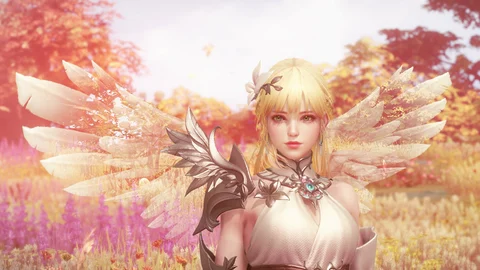
Lost Ark Wandering Merchant Guide & Tracker
The Lost Ark Wandering Merchants are special NPCs in Arkesia, who only show up at specific times and places. We sum up everything you need to know about them, including times, locations and available items.
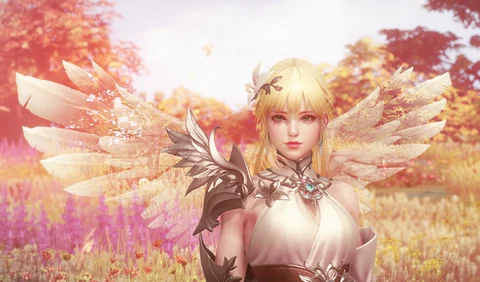
All across Arkesia, the world of Lost Ark, you will find tons of different merchants and NPCs trying to sell you something. Most of them are standard shopkeepers, who sell you items, weapons and more. But there are some special cases in Lost Ark, Wandering Merchants being chief among them. We will show you everything you need to know about Lost Ark's Wandering Merchants.
If you don't know what they are, read our explainer below. At the bottom of the article, we also have a tracker that shows when and where the Wandering Merchants show up in Lost Ark.
- Lost Ark Guide: How To Earn Pirate Coins
Lost Ark: Wandering Merchants Explained
In Lost Ark, Wandering Merchants are special NPCs that have unique items and cards , which you will needin the mid- to late game to progress in systems like the deck building and the rapport system. You need to engage with these systems to earn gold in Lost Ark or to improve your Virtues like Charisma . The Wandering Merchants in Lost Ark have items that you won't find anywhere else, but will need more off the further you progress in the game. However, the Wandering Merchants in Lost Ark have some unique characteristics that you will need to consider.
The item stock of the merchants changes all the time. What also changes is their location. They also don't appear in every region, and only at specific places on a specific schedule. It's almost like they don't want you to find them! But no worries, we will show you where to find them and when they will appear.
How To Find Lost Ark Wandering Merchants – Schedule & Locations
As you maybe already gathered, finding the Wandering Merchants in Lost Ark is complicated. There is a system behind it though, which we will show you now. There are 15 Wandering Merchants in Lost Ark, who all appear in their respective region according to one of three schedules. The Wandering Merchants are region-specific and have multiple locations that they can pop up in.
- Lost Ark Engravings Guide: Recipes, Ability Stones, Rarities & Best Setups
You will need gold in Lost Ark, and we have the best ways to earn it right here for you:
Here is a table with all Lost Ark Wandering Merchants, their locations, the items they're selling and the times they appear at. The merchants appear in one of up to six zones for 25 minutes each, usually in outposts, camps or other populated areas featuring shops and other NPCs. All times are in AM as well as PM and in accordance to the time on your server.
If you want to keep an overview of all Lost Ark Traveling Merchants, then keep this page open and come back to check all the data. We can also recommend combining our list with this nifty tool by the community .
Lost Ark Traveling Merchant Ships
There aren't just wandering merchants in Lost Ark, we also have multiple Traveling Merchant Ships making their rounds. This has not been complicated enough yet, so of course, there has to be another layer to this system. There are two Traveling Merchant Ships in Lost Ark, The Luterran Royal Trading Ship and the New Vernese Exploring Ship. They appear at one of multiple islands, every hour for 30 minutes at a time. Here are the islands where they can appear at:
- Luterran Royal Trading Ship: White Wave Island, Dreamgull Island, Sunflower Island, Starlight Isle, Lopang Island, Toto Silver Island
- New Vernese Exploring Ship: Sublime Island, Eternity Isle, Niheltalop's Thoughts, Goblin Island, Gravis, Hypnos's Eyes
The ships, of course, sell different wares. You will also need Pirate Coins to buy items, as well as Gienah's Coins. Here are all items at the Merchant Ships:
- Small Music Box (1,670 Pirate Coins)
- Stronghold Crew Application Form: Cho Jepeng (1,670 Pirate Coins)
- Stronghold Crew Application Form: Shez (1,670 Pirate Coins)
- Stronghold Crew Application Form: Jade (6,680 Pirate Coins)
- Stronghold Crew Application Form: Bijorn (6,680 Pirate Coins)
- Stronghold Crew Application Form: Lyke (10,020 Pirate Coins)
- Stronghold Crew Application Form: Fighter Austin (13,360 Pirate Coins)
- Masterpiece # 27 (10,000 Pirate Coins)
- Stronghold Crew Application Form: Daniel (167 Gienah's Coins)
- Stronghold Crew Application Form: Gaon (167 Gienah's Coins)
- Stronghold Crew Application Form: Paddler Daniel (668 Gienah's Coins)
- Stronghold Crew Application Form: Derick (668 Gienah's Coins)
- Stronghold Crew Application Form: Mercenary Captain Ronimus (1,002 Gienah's Coins)
- Stronghold Crew Application Form: Silver Chain Alice (1,336 Gienah's Coins)
All 2023 Video Games – Upcoming Release Schedule
Faris has been obsessed with gaming since his childhood and is now the Gaming lead at EarlyGame. He is a self-described FromSoftware shill, but also loves games like Tears of the Kingdom, Baldur's Gate 3 and Resident Evil 4. ...
- Share Facebook X Reddit WhatsApp Copy URL

How to find Wandering Merchants in Lost Ark
Lost Ark Wandering Merchants are in many places in Arkesia, but you must be in the right place at the right time to buy some rare items from them.

Paulo Kawanishi
04th Oct 2022 12:31
Images via Smilegate
The Lost Ark Wandering Merchants are important NPCs that are found across the various contents of Arkesia, where they offer important items that make them well sought after by players. During the Lost Ark end-game, there is a lot to do, and part of the core loop involves travelling to Wandering Merchants to see their refreshed wares, which often allow you to gain more power. So if you need a full breakdown of the Lost Ark Wandering Merchants locations and their available items, we've got you covered.
First, it is important to understand that not every region in Arkesia has a Wandering Merchant and that each NPC sells different sets of items. Check your location and whether you can reach a determined seller while they are available. Below you will find the locations of Merchants, along with the time they will be up on your server. Keep in mind that the times are AM and PM!
In case you don’t want to worry about checking the clock all the time or finding where a particular NPC is, then you can use the Lost Merchant app . It works like many other services for online games which are fed by the community. Fill in your server and region then you can see how much time until the Merchants spawn or for how long they are up. Other players will mark what are the items the NPC is currently selling and their location as well.
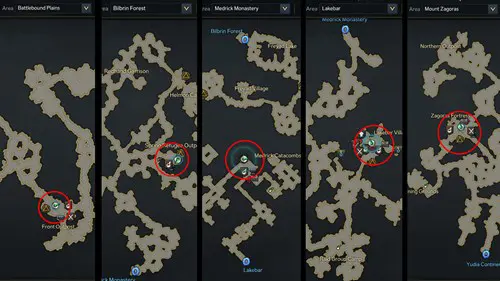
West Luterra’s Wandering Merchant is up at 12:30, 2:30, 5:30, 6:30, 8:30, and 9:30, and they can be found in Mount Zagoras, Lakebar, Medrick Monastery, Bilbrin Forest, and Battlebound Plains. Among the items they sell, there are the Berhart, Cadogan, and Cassleford cards, as well as Black Rose, Lakebar Tomato Juice, Stalwart Cages, and Chain War Chronicles which are rapport items.
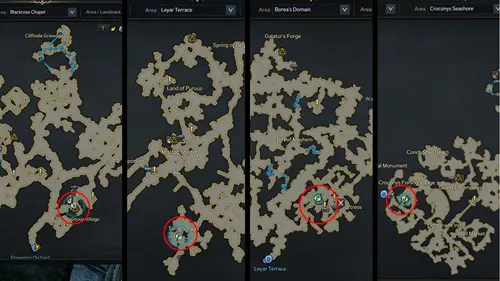
You can find Burt in Blackrose Chapel, Leyar Terrace, Borea’s Domain, and Croconys Seashore. The times they appear during the day are 12:30, 2:30, 5:30, 6:30, 8:30, 9:30, and you can buy Nox, Seria, and Thunderwings cards or Azenoporium Brooch, Dyorika Straw Hat, a Model of Luterra’s Sword, and Chain War Chronicles rapport items.
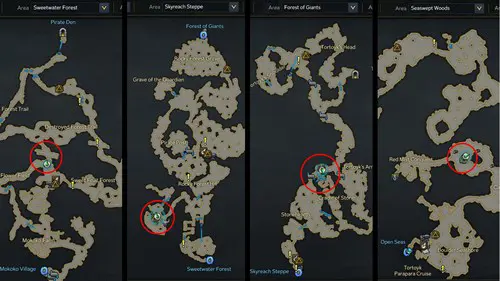
In the small world of Tortoyk you can find Oliver in Seaswept Woods, Sweetwater Forest, Skyreach Steppe, and Forest of Giants. They are up in these regions at the following times: 12:30, 2:30, 5:30, 6:30, 8:30, 9:30. From them, you can buy cards like Egg of Creation, Eolh, and Mokamoka. The rapport items that they sell are Mokoko Carrot, Oversized Ladybug Doll, Round Glass Piece, and Shy Wind Flower Pollen.
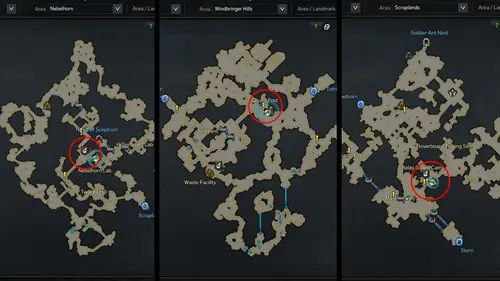
Among the Wandering Merchants, Nox is the one that shifts their location the most. You may find them in Scraplands, Nebelhorn, Windbringer Hills, Totrich, Riza Falls, and Arid Path at 12:30, 2:30, 5:30, 6:30, 8:30, 9:30. Once you locate Nox, they might be selling the Bergstrom, Stern Neria, or Krause cards and the Energy X7 Capsule and Fine Gramophone rapport items. Because Nox has six locations, the image below is also included.
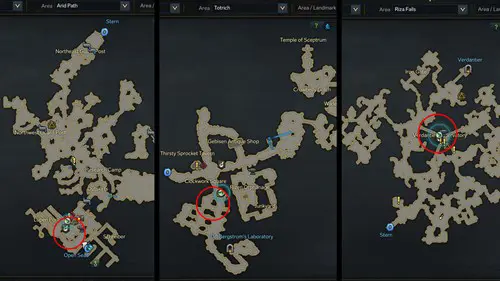
Ben can be found at 12:30, 3:30, 4:30, 6:30, 7:30, 10:30. They don’t change a lot of places, since you might find them in Ankume Mountain, Rethramis Border, or Loghill. Ben’s bag carries Siera, Prideholme Neria, or Varut cards, as well as Fancier Bouquet, Pridehome Potato, Rethramis Holy Water, or Surprise Chest rapport items.
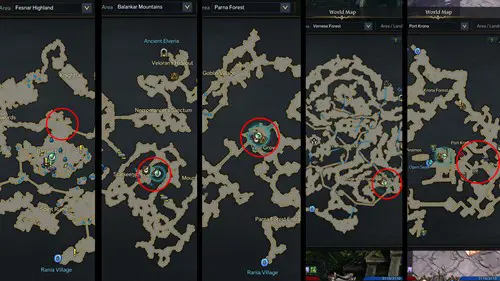
In the continent of North Vern, you may find Peter in one of these locations: Port Krona, Fesnar Highland, Balankar Mountains, Parna Forest, or Vernese Forest at 12:30, 3:30, 4:30, 6:30, 7:30, 10:30. When you find this Wandering Merchant, they might be selling the Gideon, Payla, or Thar card and the Crystallized Magick, Exquisite Music Box, Goblin Yam, Magick Cloth, Queen’s Knights Application, or Vern’s Founding Coin rapport item.
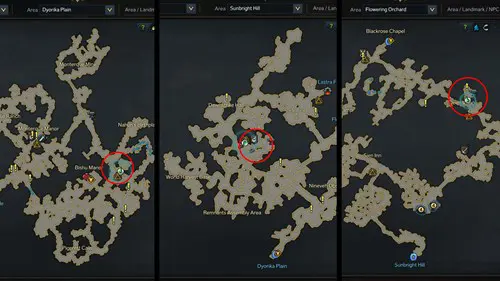
While Burt covers some places in East Luterra, others like Dyorika Plain, Sunbright Hill, and Flowering Orchard are the places where you can find Morris at 1:30, 4:30, 5:30, 7:30, 8:30, and 11:30. Among other things, Morris may be selling cards like Brinewt, Morpheo, Meehan, and Thunderwings as well as the rapport items such as Azenoporium Brooch, Dyorika Straw Hat, Model of Luterra’s Sword, Chain War Chronicles.
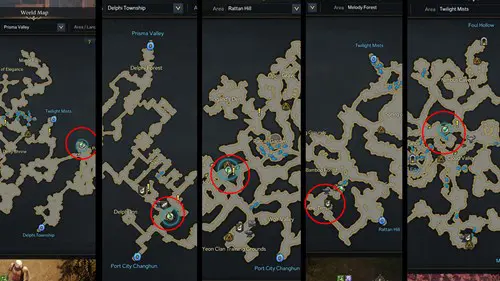
Anikka’s Wandering Merchant, Mac can be found in Delphi Township, Rattan Hill, Melody Forest, Twilight Mists, and Prisma Valley at 1:30, 4:30, 5:30, 7:30, 8:30, and 11:30. In case you are looking for the Madam Moonscent, Sir Druden, Sir Valleylead, or Wei cards as well as the Tournament Entrance Stamp and Angler’s Fishing Pole rapport items, Mac sells them.
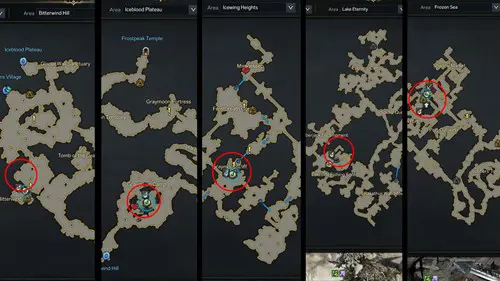
The cold lands of Shushire are Jeffrey’s area who can be found in Frozen Sea, Bitterwind Hill, Iceblood Plateau, Icewing Heights, and Lake Eternity at 1:30, 4:30, 5:30, 7:30, 8:30, and 11:30. This Wandering Merchant is the one you are looking for if you want to buy Javern, Sian, or Madnick cards and the rapport items Shimmering Essence and Siriu’s Holy Book.
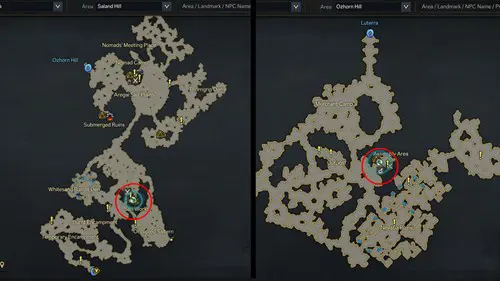
Yudia is a small region and that is why finding Lucas won’t be hard. They can be in Saland Hill or Ozhorn Hill at 1:30, 4:30, 5:30, 7:30, 8:30, and 11:30. By going to Lucas, you can get your hands on the Giant Worm, Morina, or Thunder cards, as well as Yudia Natural Salt, Yudia Spellbook, or Sky Reflection Oil rapport items!
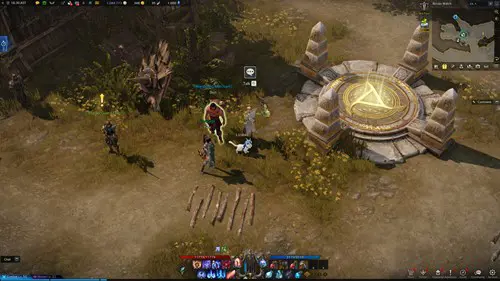
Lost Ark has many systems for players to interact with, such as the deck building and the Lost Ark Rapport system. The Wandering Merchants are extremely important to progress in both systems since they have a selection of cards and items that you won’t find anywhere else. On the other hand, the selection of items they will be selling changes each time.
However, the downside of the Wandering Merchants is that they travel all the time. So, their location shifts and can be in a number of random locations across the continents. These NPCs are on somewhat randomized schedules and only remain for 25 minutes in each of the game's channels, which can be accessed from the drop-down in the top right. Because of that, knowing what you may want to buy or where you should look for them is the best way to prepare yourself ahead of time.
This is the list of Wandering Merchants to help your life in Lost Ark !
Since you will be visiting many places, you can also use the opportunity to hunt some Lost Ark World Bosses .
About The Author
Paulo Kawanishi is a Brazilian freelance writer. While trying to keep up with all the releases, he is always playing old games or walking in Eorzea. He is also finishing a Ph.D. on Applied Linguistics which helps him to talk more about games.
There are no comments yet for this article...
Be the first to add a comment and take the lead on the conversations

Lost Ark Break Through to Thaemine patch release date, Breaker Advanced Class & more
Check out everything we know about the Lost Ark Break Through to Thaemine patch, including the release date, Breaker Advanced Class, new quests, and more.

Lost Ark September update patch notes: Jump-Start servers, Legendary Skins & more
If you want to know all of the latest updates in Lost Ark such as Yoz's Jar and the new skins added to the Store, make sure to keep reading for the patch notes.

Lost Ark Roadmap Part 3 2023: Souleater class, Prime Island Battle Royale & more
Here's our full breakdown of Lost Ark Roadmap Part 3 for 2023, detailing all the latest changes set to come to the game in the following months of the year.

Lost Ark August 2023 update: Aeromancer class, Akkan Legion raid & more
The Lost Ark August 2023 update is the final update in the summer content roadmap, which will add a new Aeromancer class, and two raids.
More Like This

Tarran Stockton
25 weeks ago

Amy Eastland
52 weeks ago

57 weeks ago

56 weeks ago

Lost Ark July 2023 patch notes: Kakul-Saydon Inferno mode, Elgacia epilogue, updates, bug fixes & more
Here's our Lost Ark July 2023 update breakdown, which covers all the content coming in the summer update, such as a new Inferno mode raid, the Elgacia epilogue, and more.
61 weeks ago

Lost Ark June 2023 update: Elgacia continent, new dungeon & more
Check out everything we know about the Lost Ark June 2023 update, as it adds a bunch of important content, such as the new continent of Elgacia.
71 weeks ago

Lost Ark May 2023 update: New Slayer class, progression changes & more
Check out our breakdown of the Lost Ark May 2023 update, including the new Slayer class, Ebony Cube activity, progression changes, and more.

Lost Ark April update: Release date, new content, & more
Lost Ark is an ever-evolving game, and players can expect new content with the April update. We have some of the early details, so take a look.

Dave McAdam
74 weeks ago

Lost Ark Stone Cutting Guide
Check out our Lost Ark Stone Cutting guide for a full explainer of how to make the most of Ability Stones and become more powerful.
81 weeks ago

Everything You Need To Know About The Lost Ark Anniversary Event
Want to know all about the Lost Ark Anniversary event? Check out all there is to know, including the new continent of Rowen, and the Twitch drops you can earn.

How to start the Lost Ark X Witcher event
Want to know how to get started with the Lost Ark X Witcher event? Take a look at our breakdown of where to begin the new event questline.
86 weeks ago

How to get the Lost Ark Witcher skins
Want to know how you can get your hands on the Lost Ark Witcher skins? Take a look at our explainer of how you can come away from this new crossover event with a Geralt and Ciri skin.

How to fix the 'Universal storage missing' bug in Lost Ark
If you have run into the Lost Ark Universal Storage missing problem and need to know how to fix it, we've got you covered.
101 weeks ago

Lost Ark Machinist: All Skills And Engravings
Here is our breakdown of the new Lost Ark Machinist class, which will be available on September 28.
103 weeks ago

How to find the Requiem of Twilight in Lost Ark
Take a look at you can find the Lost Ark Requiem of Twilight sheet music, along with that it's used for.
104 weeks ago

When is the Female Berserker releasing in Lost Ark?
If you're wondering when the Female Berserker is set to release in Lost Ark, check out everything we know so far about when you can expect to play.

How To Get Lost Ark Eternity Isle Token
Here is our breakdown for earning the Lost Ark Eternity Isle Token.
105 weeks ago

How To Get Lost Ark Hope Island Token
Here is a breakdown of how to get the Lost Ark Hope Island Token to add to your collection.

Lost Ark Shiba Inu: How To Get
Come Look At The Adorable Lost Ark Shiba Inu Pets And Learn How You Can Get Them.
107 weeks ago

Lost Ark Pet Ranch: Everything You Need to Know
Check Out Everything You Need To Know About The Lost Ark Pet Ranch.
- Privacy Policy
- Cookies Policy
2024 GGRecon. All Rights Reserved

To Our newsletter
Get exclusive news, content, and discounts sent directly to your inbox’

Lost Ark: All Wandering Merchant Locations & Spawn Times
The concept of a wandering merchant is quite common in MMORPGs and Lost Ark is no exception. These traders have multiple areas where they can spawn in a region. Thus finding one can be tough, and if that wasn’t enough they stay in that location for a short time. The reason for such a mechanism is they sell special and rare items. Thus it makes sense that they aren’t always available. But worry not, finding them is easy once you know where to look for them. So without further ado let us check all locations for Wandering Merchant in Lost Ark and their spawn times.
All Wandering Merchant Locations in Lost Ark & Spawn Times

Wandering Merchants, as the name suggests, spawn in different areas and regions of the map. They spawn almost everywhere with the exception of city and dungeon zones. Each of them can spawn at a different time based on the region and will stay available for 25 minutes.
A good way to find them out is to look for alerts on the chat. Once some player finds a merchant’s location they can notify everyone, similarly if you find a merchant you should do the same. These are all the wandering merchants in the game, and the regions where you can find them:
Below are all the areas in each region and the spawn times where they spawn. Thanks to Map Genie.io for their interactive map.
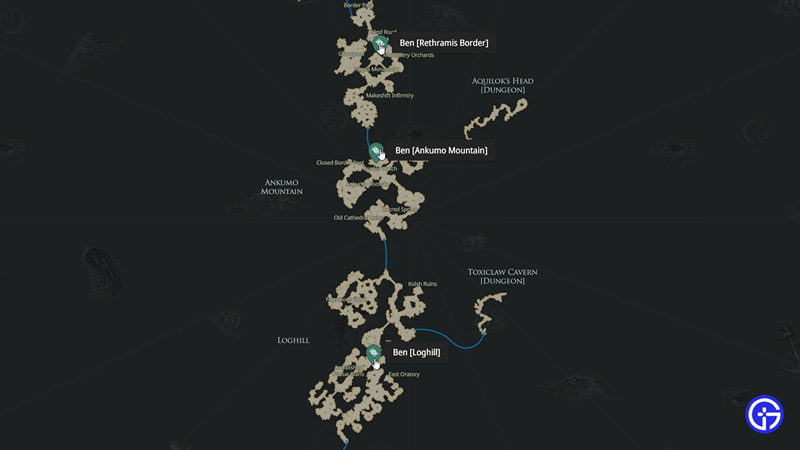
Ben can spawn at Rethramis in the following areas:
- Rethramis Border
- Ankumo Mountain
Their spawn times are:
- 12:30, 3:30, 4:30, 6:30, 7:30, 10:30 (both AM and PM as per the server time)

Lucas can spawn at Yudia in the following areas:
- Ozhorn Hill
- Saland Hill
- 1:30, 4:30, 5:30, 7:30, 8:30, 11:30 (both AM and PM as per the server time)
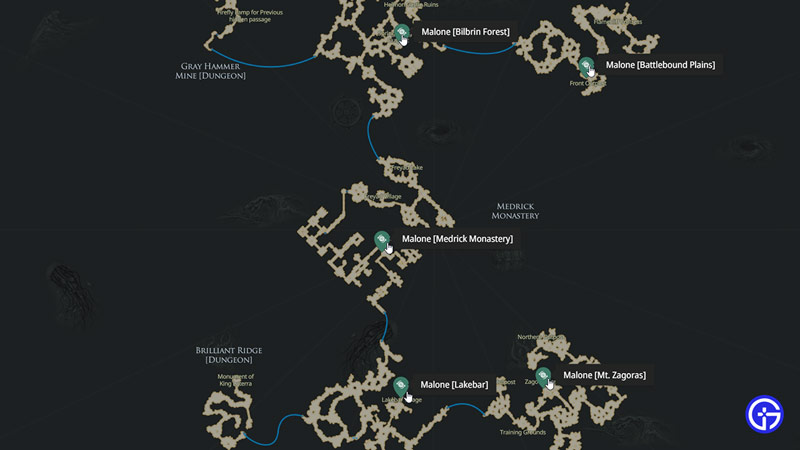
Malone can spawn at West Luterra in the following areas:
- Bilbrin Forest
- Battlebound Plains
- Medrick Monastery
- Mt. Zagoras
- 12:30, 2:30, 5:30, 6:30, 8:30, 9:30 (both AM and PM as per the server time)
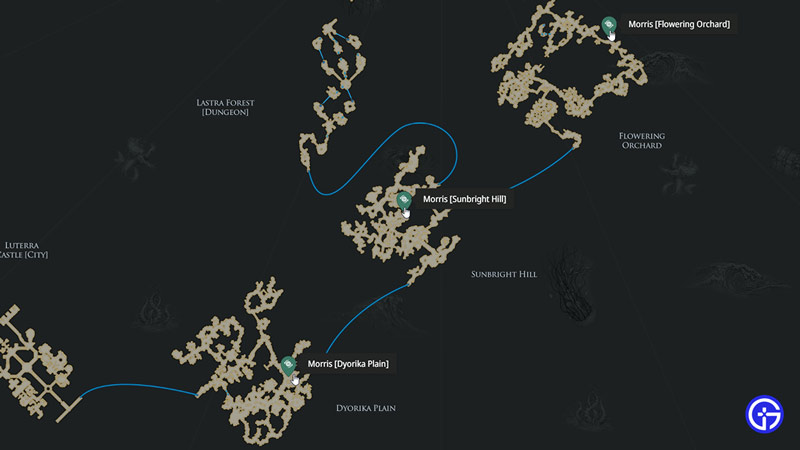
Morris can spawn at East Luterra in the following areas:
- Flowering Orchard
- Sunbright Hill
- Dyorika Plain

Burt can spawn at East Luterra in the following areas:
- Croconys Seashore
- Borea’s Domain
- Blackrose Chapel
- Leyar Terrace
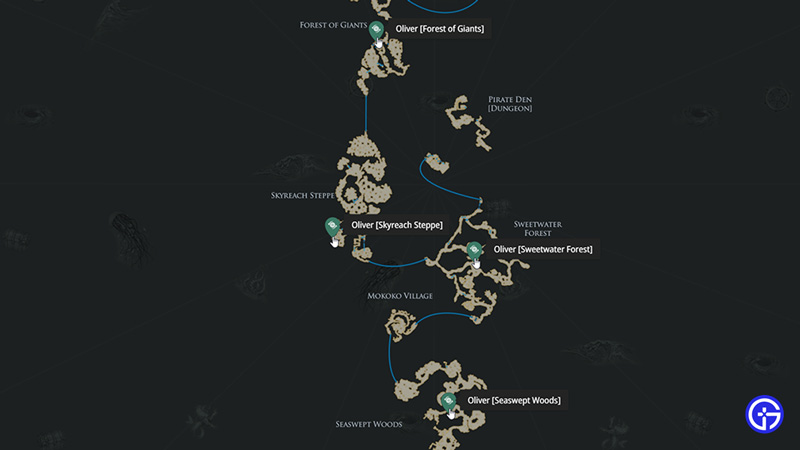
Oliver can spawn at Tortoyk in the following areas:
- Forest of Giants
- Skyreach Steppe
- Sweetwater Forest
- Seaswept Woods
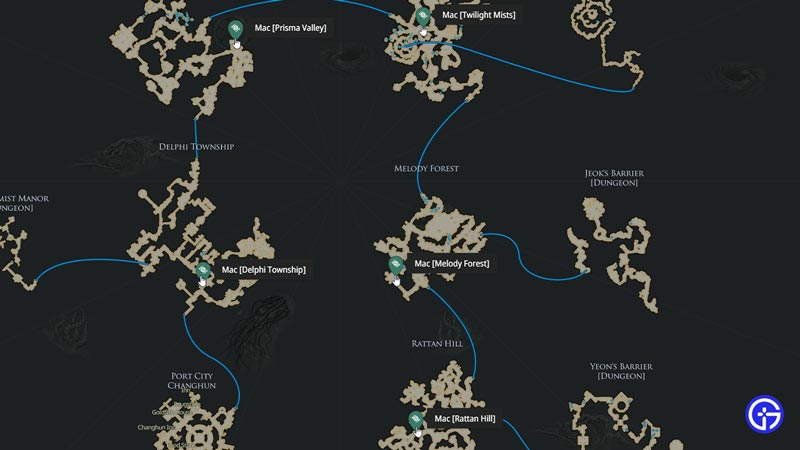
Mac can spawn at Anikka in the following areas:
- Twilight Mists
- Prisma Valley
- Melody Forest
- Delphi Township
- Rattan Hill
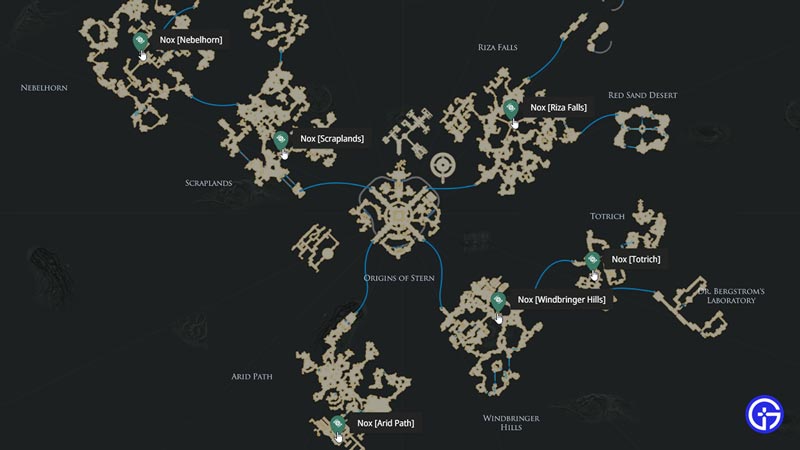
Nox can spawn at Arthetine in the following areas:
- Windbringer Hills

Peter can spawn at North Vern in the following areas:
- Fesnar Highland
- Vernese Forest
- Parna Forest
- Balankar Mountains
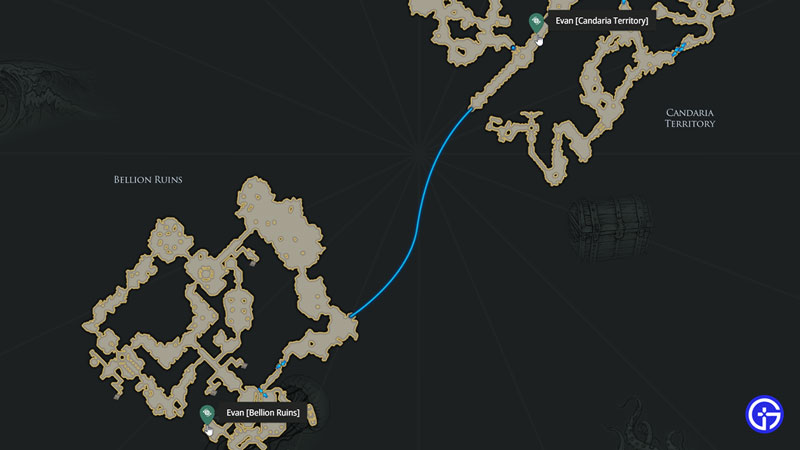
Evan can spawn at South Vern in the following areas:
- Candaria Territory
- Bellion Ruins
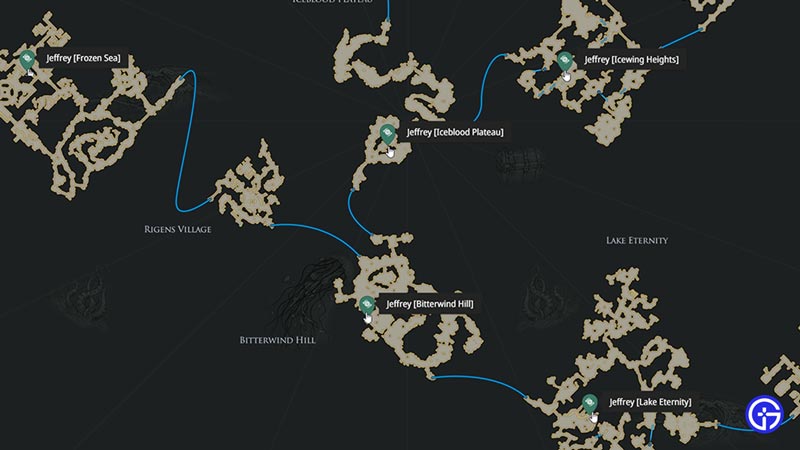
Jeffrey can spawn at Shushire in the following areas:
- Icewing Heights
- Iceblood Plateau
- Bitterwind Hill
- Lake Eternity
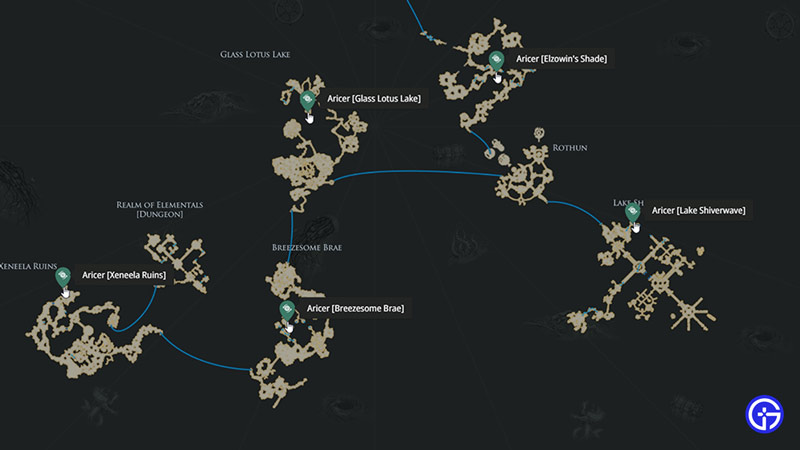
Aricer can spawn at Rohendel in the following areas:
- Elzowin’s Shade
- Glass Lotus Lake
- Lake Shiverwave
- Xeneela Ruins
- Breezesome Brae

Laitir can spawn at Yorn in the following areas:
- Unfinished Garden
- Hall of Promise
- Black Anvil Mine
- Iron Hammer Mine
- Yorn’s Cradle
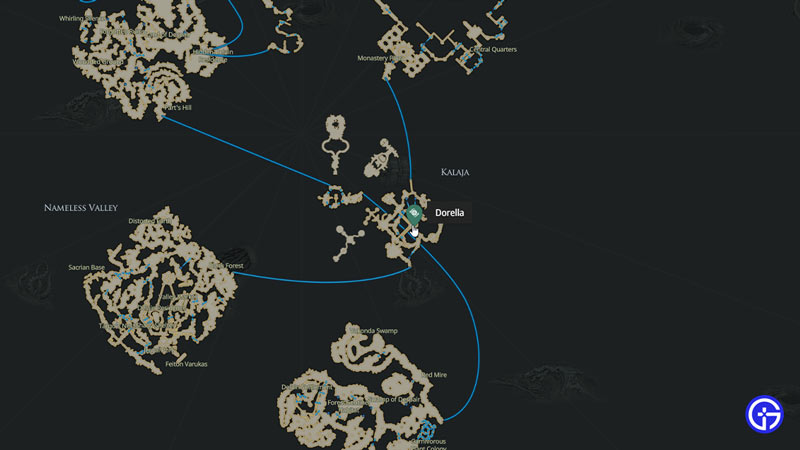
Dorella can spawn at Feiton in the following areas:
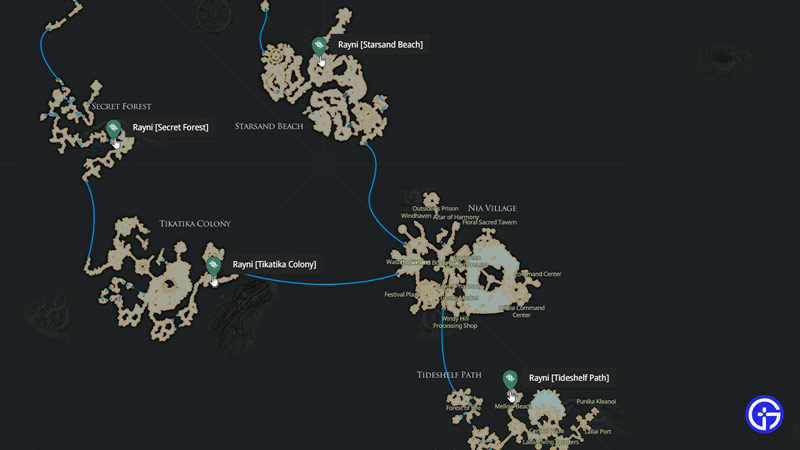
Rayni can spawn at Punika in the following areas:
- Starsand Beach
- Secret Forest
- Tikatika Colony
- Tideshelf Path
That covers all Wandering Merchant locations in Lost Ark and their spawn times. If you are interested in other locations, NPCs, and more for this game then check out our other Lost Ark guides.
Karan is a Soulsborne enjoyer who grew up playing NES classics like Contra, Mario, Zelda, Kirby, Megaman, and a list of other games that go on. He also enjoys FPS games like Overwatch 2 and Valorant. Currently, he is maining Cammy in Street Fighter 6, while experimenting some Sorcerer builds in Diablo 4. And if you need help with some boss fights in a game, he is your guy!
Related Posts
Extreme run: greatest thrill for casual gamers:, satisfactory: how to fix plugin sml failed to load error, how to fix blurry graphics in space marine 2, space marine 2 opening cutscene freezing and game crashing.
Type above and press Enter to search. Press Esc to cancel.
Where to find Wandering Merchants in Lost Ark – All Wandering Merchant Locations
Never miss a Wandering Merchant again.
- October 17, 2022
- Guides Lost Ark
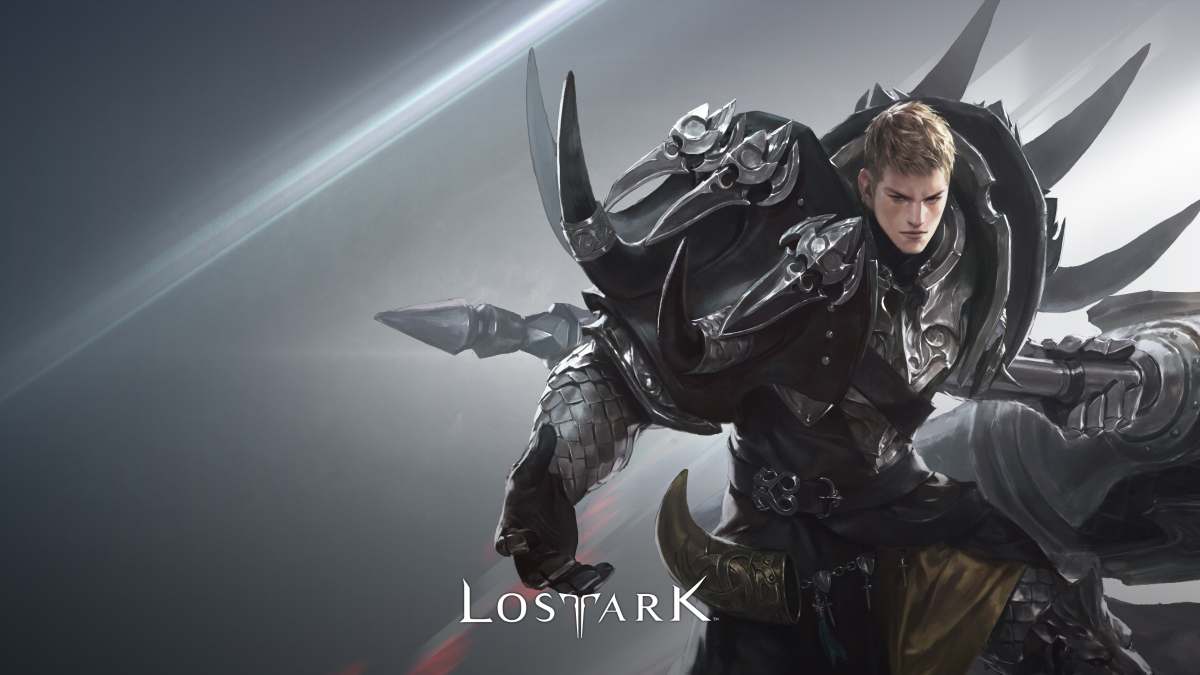
Image via Smilegate
There are many equally important elements to keep track of during the end-game of Lost Ark. With resource gathering, managing your mansion, killing bosses on a timer, as well as all of the group content in place, there is much to do for a serious player. One of those end-game activities also involves looking out for the Wandering Merchants in all of Arkesia’s nooks and crannies. These guys spawn in predetermined locations on semi-random timers and you want to seek them out because they offer some important wares.
Each one has a distinct table of goods but will only offer a limited selection each time they spawn. That makes getting everything you need from each of them a bit of a grind to begin with. In order to make that grind slightly less frustrating, we have prepared a guide that explains where to find each Wandering Merchant in Lost Ark and their locations within their given regions.
Related: Where are the Bloodstone vendors in Lost Ark? Answered
Where to find Wandering Merchants in Lost Ark
Every one of the Wandering Merchants in Lost Ark will spawn at a randomly scheduled time in a random location within their region. Once spawned, they will stay in place for about 25 minutes, before wandering on to a different locale.
They can even spawn in some game channels (‘instances’ in other MMO terms), then move along to others. You can access game channels from the drop-down menu in the top-right corner of your game screen.
These merchants sell many goodies involved with late-game systems, including some Cards and Rapport items that are only available in their shop lists, making them the only source of those goods in the game if you’re looking to complete your collections.
Merchant Malone locations in West Luterra
Merchant Malone is the Wandering Merchant in the West Luterra region of Lost Ark. His schedule is to show up at 12:30, 2:30, 5:30, 6:30, 8:30, and 9:30 (both AM and PM) server time. He can be randomly found in:
- Battlebound Plains
- Bilbrin Forest
- Medrick Monastery
- Mount Zagoras
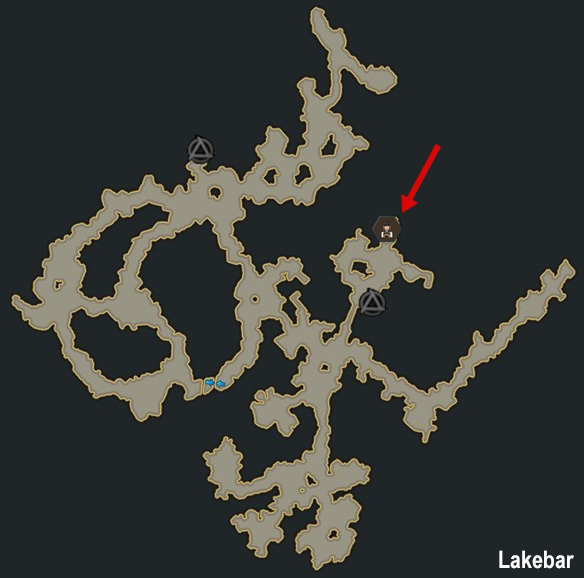
When you find him, his special shop wares are a random selection from:
- Hairplant (777 Silver Coins)
- Cassleford Card (8.000 Silver Coins)
- Cadogan Card (5.000 Silver Coins)
- Berhart Card (5.000 Silver Coins)
- Stalwart Cage (10.000 Silver Coins)
- Lakebar Tomato Juice (10.000 Silver Coins)
- Black Rose (10.000 Silver Coins)
- Chain War Chronicles (80.000 Silver Coins)
Merchant Burt locations in East Luterra
Merchant Burt is the first Wandering Merchant in the East Luterra region of Lost Ark. His schedule is to show up at 12:30, 2:30, 5:30, 6:30, 8:30, and 9:30 (both AM and PM) server time. He can be randomly found in:
- Blackrose Chapel
- Leyar Terrace
- Borea’s Domain
- Croconys Seashore (at two locations)
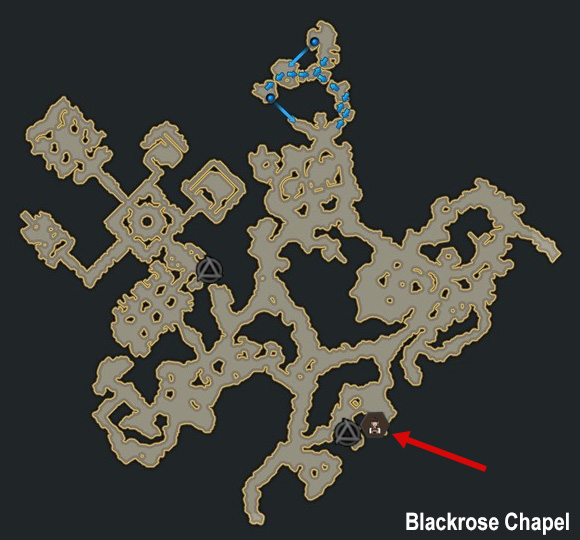
- Hot Chocolate Coffee (8.000 Silver Coins)
- Thunderwings Card (40.000 Silver Coins)
- Seria Card (8.000 Silver Coins)
- Nox Card (10.000 Silver Coins)
- Dyorika Straw Hat (10.000 Silver Coins)
- Model of Luterra’s Sword (10.000 Silver Coins)
- Azenaporium Brooch (10.000 Silver Coins)
Merchant Morris locations in East Luterra
Merchant Morris is the second Wandering Merchant in the East Luterra region of Lost Ark. His schedule is to show up at 1:30, 4:30, 5:30, 7:30, 8:30, and 11:30 (both AM and PM) server time. He can be randomly found in:
- Dyorika Plains
- Flowering Orchard
- Sunbright Hill
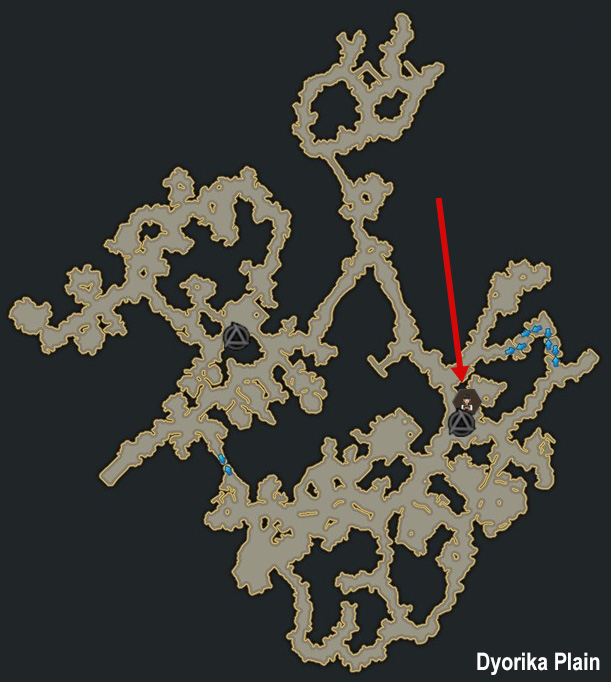
- Dry-aged Meat (777 Silver Coins)
- Meehan Card (8.000 Silver Coins)
- Brinewt Card (5.000 Silver Coins)
- Morpheo Card (5.000 Silver Coins)
Merchant Oliver locations in Tortoyk
Merchant Oliver is the Wandering Merchant in the Tortoyk region of Lost Ark. His schedule is to show up at 12:30, 2:30, 5:30, 6:30, 8:30, and 9:30 (both AM and PM) server time. He can be randomly found in:
- Sweetwater Forest
- Skyreach Steppe
- Forest of Giants
- Seaswept Woods
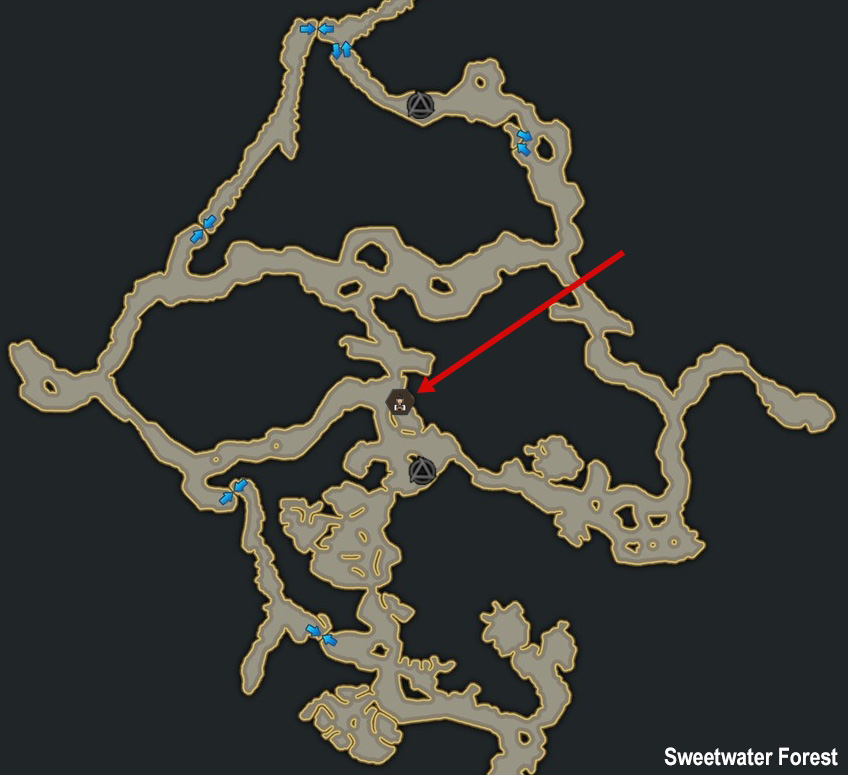
- Mokamoka Card (40.000 Silver Coins)
- Eolh Card (8.000 Silver Coins)
- Egg of Creation Card (5.000 Silver Coins)
- Round Glass Piece (10.000 Silver Coins)
- Mokoko Carrot (10.000 Silver Coins)
- Oversized Ladybug Doll (10.000 Silver Coins)
- Shy Wind Flower Pollen (80.000 Silver Coins)
Merchant Nox locations in Arthetine
Merchant Nox is the Wandering Merchant in the Arthetine region of Lost Ark. His schedule is to show up at 12:30, 2:30, 5:30, 6:30, 8:30, and 9:30 (both AM and PM) server time. He can be randomly found in:
- Windbringer Hills
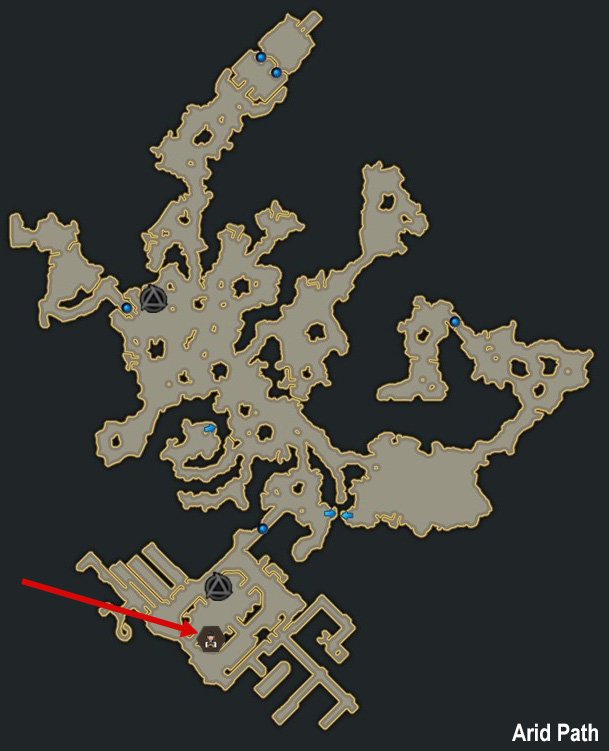
- Adrenaline-boosting Fluid (777 Silver Coins)
- Krause Card (40.000 Silver Coins)
- Stern Neria Card (8.000 Silver Coins)
- Bergstrom Card (8.000 Silver Coins)
- Fine Gramophone (80.000 Silver Coins)
- Energy X7 Capsule (10.000 Silver Coins)
Merchant Ben locations in Rethramis
Merchant Ben is the Wandering Merchant in the Rethramis region of Lost Ark. His schedule is to show up at 12:30, 3:30, 4:30, 6:30, 7:30, and 10:30 (both AM and PM) server time. He can be randomly found in:
- Ankumo Mountain
- Rethramis Border
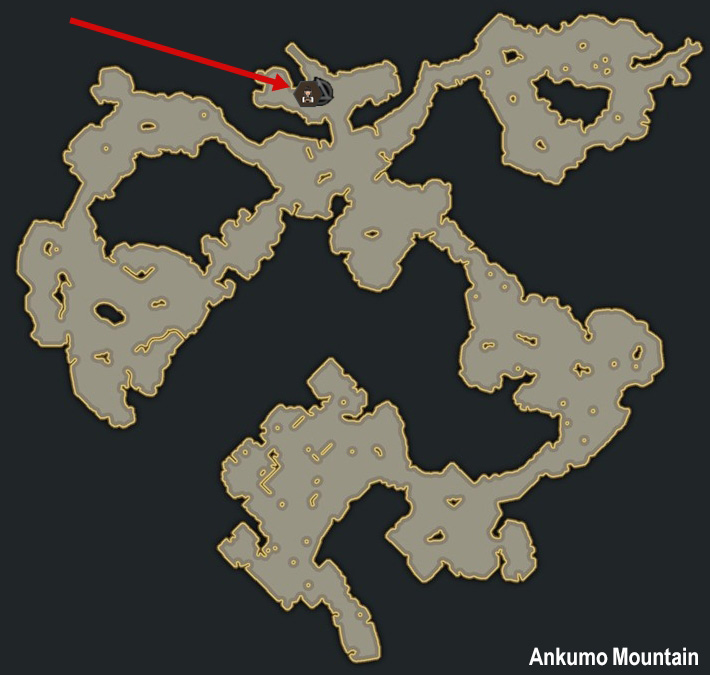
- Varut Card (8.000 Silver Coins)
- Prideholme Neria Card (8.000 Silver Coins)
- Siera Card (5.000 Silver Coins)
- Fancier Bouquet (10.000 Silver Coins)
- Prideholme Potato (10.000 Silver Coins)
- Rethramis Holy Water (10.000 Silver Coins)
- Pit-a-Pat Chest (80.000 Silver Coins)
Merchant Peter locations in North Vern
Merchant Peter is the Wandering Merchant in the North Vern region of Lost Ark. His schedule is to show up at 12:30, 3:30, 4:30, 6:30, 7:30, and 10:30 (both AM and PM) server time. He can be randomly found in:
- Krona Harbor
- Vernese Forest
- Balankar Mountains
- Fesnar Highland
- Parna Forest
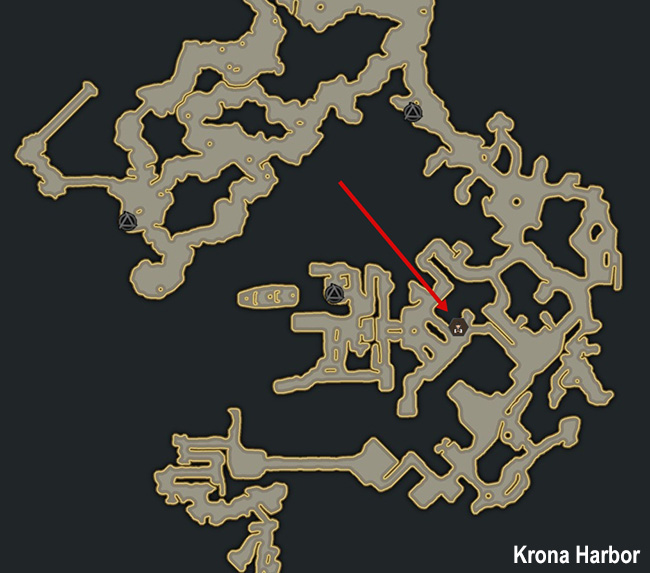
- Thar Card (40.000 Silver Coins)
- Gideon Card (8.000 Silver Coins)
- Payla Card (8.000 Silver Coins)
- Magick Cloth (10.000 Silver Coins)
- Crystallized Magick (10.000 Silver Coins)
- Exquisite Music Box (10.000 Silver Coins)
- Queen’s Knights Application (10.000 Silver Coins)
- Goblin Yam (10.000 Silver Coins)
- Vern’s Founding Coin (80.000 Silver Coins)
Merchant Mac locations in Anikka
Merchant Mac is the Wandering Merchant in the Anikka region of Lost Ark. His schedule is to show up at 1:30, 4:30, 5:30, 7:30, 8:30, and 11:30 (both AM and PM) server time. He can be randomly found in:
- Melody Forest
- Prisma Valley
- Twilight Mists
- Rattan Hill
- Delphi Township
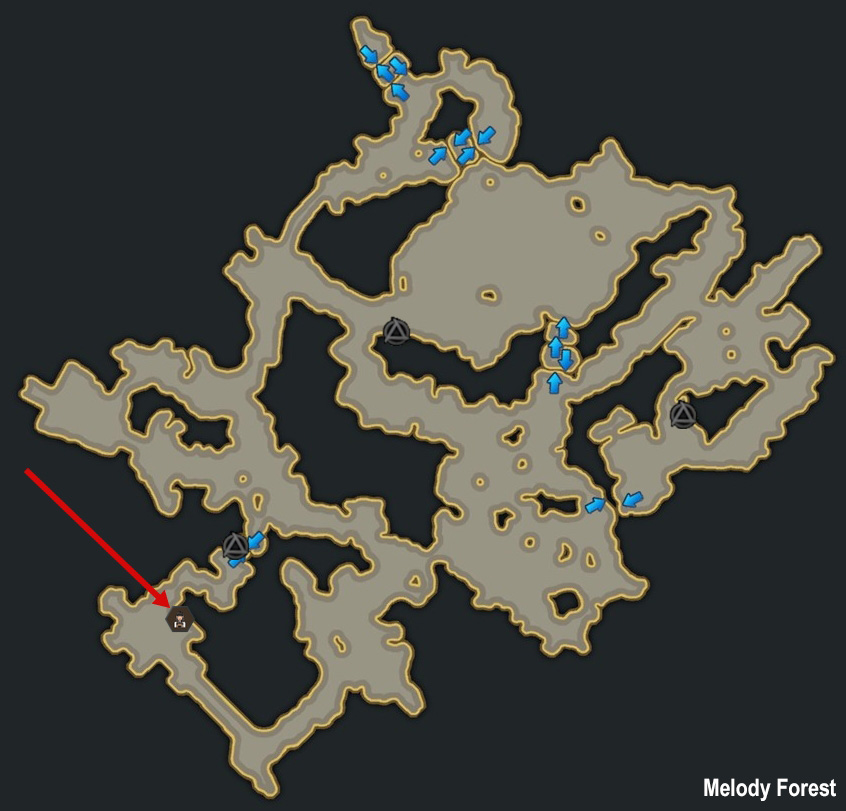
- Wei Card (200.000 Silver Coins)
- Sir Druden Card (5.000 Silver Coins)
- Sir Valleylead Card (5.000 Silver Coins)
- Madam Moonscent Card (5.000 Silver Coins)
- Angler’s Fishing Pole (80.000 Silver Coins)
- Tournament Entrance Stamp (10.000 Silver Coins)
Merchant Jeffrey locations in Shushire
Merchant Jeffrey is the Wandering Merchant in the Shushire region of Lost Ark. His schedule is to show up at 1:30, 4:30, 5:30, 7:30, 8:30, and 11:30 (both AM and PM) server time. He can be randomly found in:
- Lake Eternity
- Bitterwind Hill
- Iceblood Plateau
- Icewing Heights
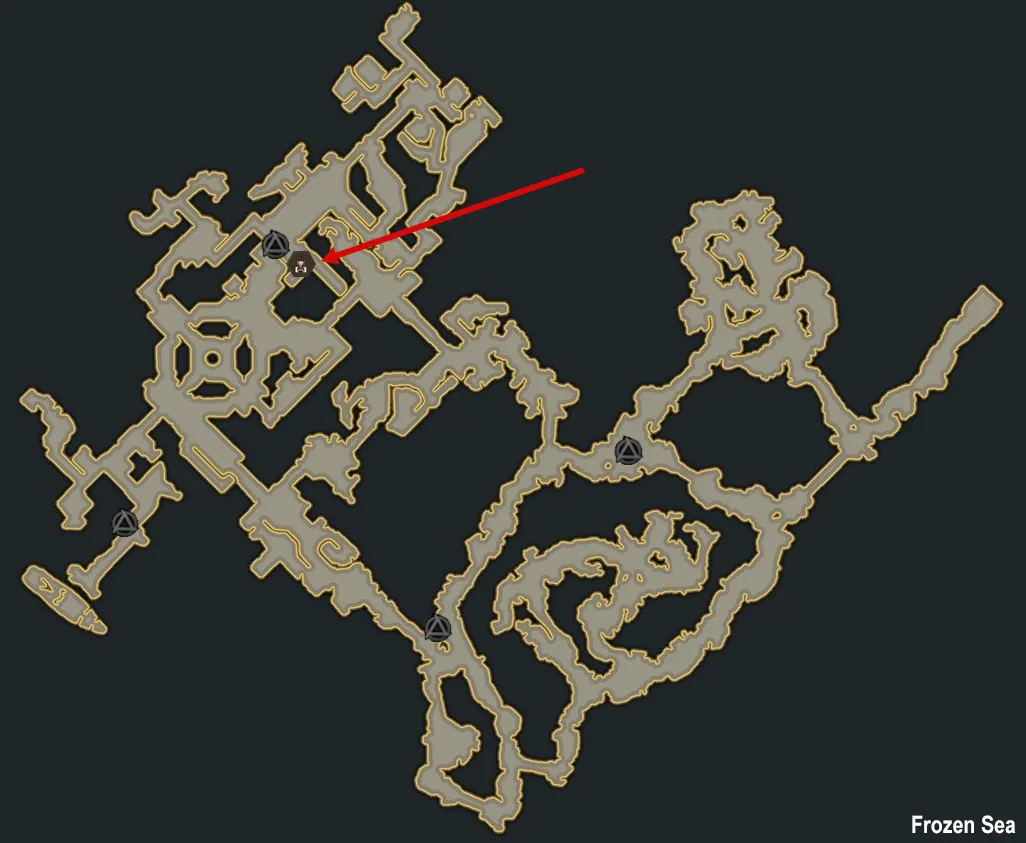
- Sapphire Sardine (777 Silver Coins)
- Madnick Card (40.000 Silver Coins)
- Sian Card (8.000 Silver Coins)
- Javern Card (8.000 Silver Coins)
- Sirius’s Holy Book (80.000 Silver Coins)
- Shimmering Essence (10.000 Silver Coins)
Merchant Lucas locations in Yudia
Merchant Lucas is the Wandering Merchant in the Yudia region of Lost Ark. His schedule is to show up at 1:30, 4:30, 5:30, 7:30, 8:30, and 11:30 (both AM and PM) server time. He can be randomly found in:
- Ozhorn Hill
- Saland Hill
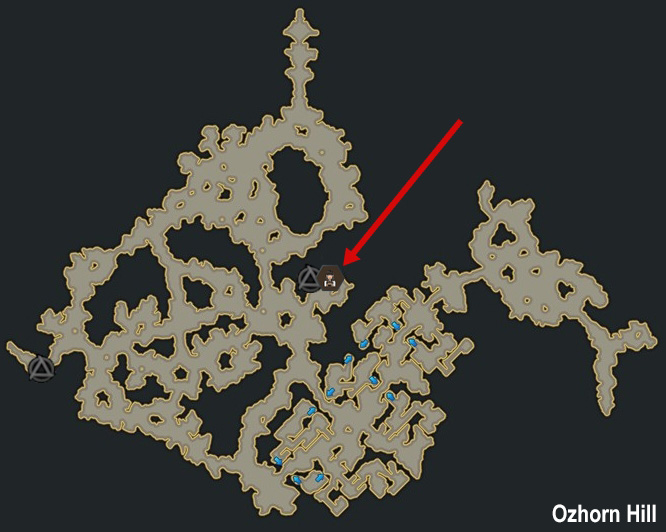
- Thunder Card (8.000 Silver Coins)
- Giant Worm Card (5.000 Silver Coins)
- Morina Card (5.000 Silver Coins)
- Yudia Natural Salt (10.000 Silver Coins)
- Sky Reflection Oil (80.000 Silver Coins)
- Yudia Spellbook (10.000 Silver Coins)
About the author
Miljan Truc
I have been into gaming since the days of Sega Mega Drive and Amiga. Over the years in gaming, I have raided at a high level, completed rare achievements, coached other players, and written about games since 2016. Whether it’s been clicking heads; developing cities, colonies, and empires; or commanding parties of adventurers; I’ve always prided myself on being able to understand the underlying mechanics of games. Outside of gaming, I enjoy a variety of activities and hobbies, including playing with my pup Astra, working out, as well as crafting, painting, and leatherwork.
More Stories by Miljan Truc
- Privacy Policy
- Terms of Service
- Ethics Policy
- Ownership Policy
- Corrections Policy
- Fact-Checking Policy
© 2024, Gamepur. All rights reserved
Lost Ark: A Guide To The Traveling Merchant

Your changes have been saved
Email is sent
Email has already been sent
Please verify your email address.
You’ve reached your account maximum for followed topics.
Why Now is the Ideal Time for Battlefield to Finally Pull The Trigger on Dino Mode
Honkai: star rail - skysplitter puzzle guide (pathfinder, hexanexus remake & navigation compass), overwatch 2 teases tank changes and sombra nerf, quick links, merchant spawn locations, wandering merchant schedules, wandering merchant wares, traveling merchant ships, merchant ship wares.
Items are essential for success in any RPG. Whether it's having the right sword to beat a boss or the right gift to win the heart of an NPC, items help the player to achieve a number of important objectives. Usually getting a new item is a simple matter of visiting a shop, but in some games it's more complicated.
RELATED: Lost Ark: Oreha Preveza Abyssal Dungeon Raid Guide
Most items in Lost Ark can be gained by conventional means, but for certain rare and exceptional items there's only one option: Wandering Merchants. Whether these are merchant ships or solitary sellers, Wandering Merchants travel the world, forcing players to track them down if they want their valuable wares. Here's everything the player needs to know about these elusive sellers in Lost Ar k.
The first type of Wandering Merchant is the Regional Wandering Merchant, which can spawn in all zones except for city maps and dungeons. The schedule for their appearances can seem complex but follows a reliable pattern, so finding them isn't much more difficult than buying Chaos Shards once the player knows where to look.
RELATED: Lost Ark: Tranquil Karkosa Abyssal Dungeon Raid Guide
Merchants follow one of three possible schedules, appearing in all channels in the zone. After 25 minutes, the Wandering Merchant will disappear. There are 2-6 possible zone spawn locations for a Merchant per region, and where the Merchant will appear is determined randomly each time they spawn. There's nothing stopping players from camping these spawn locations, pinging their friends, and alerting everyone to the Wandering Merchant's arrival when they appear.
The good news is that the three schedules that determine Wandering Merchant spawns are extremely reliable, unlike NPC schedules in some other games like Lost Ark. It's important to note that the times below are based on the player's server.
- Schedule 1: 1:30, 4:30, 5:30, 7:30, 8:30, 11:30 (AM and PM). Lucas (Yudia), Morris (East Luterra), Mac (Anikka), Jeffrey (Shushire), and Dorella (Feiton) follow Schedule 1.
RELATED: Lost Ark: Aira's Oculus Abyssal Dungeon Raid Guide
- Schedule 2: 12:30, 2:30, 5:30, 6:30, 8:30, 9:30 (AM and PM). Malone (West Luterra), Burt (East Luterra), Oliver (Tortoyk), Nox (Arthetine), Aricer (Rohendel), and Rayni (Punika) follow Schedule 2.
- Schedule 3: 12:30, 3:30, 4:30, 6:30, 7:30, 10:30 (AM and PM). Ben (Rethramis), Peter (North Vern), Laitir (Yorn), and Evan (South Vern) follow Schedule 3.
Every Wandering Merchant offers a different selection of wares, including valuble Rapport items to win over NPCs, making it important for players to know who to seek out for the items they need.
- Ben sells the Fancier Bouquet, Prideholme Potato, Rethramis Holy Water, Surprise Chest, Prideholme Neria Card, Varut Card, and Siera Card.
- Lucas sells the Yudia Spellbook, Yudia Natural Salt, Sky Reflection Oil, Giant Worm Card, Morina Card, and Thunder Card.
- Malone sells the Black Rose, Lakebar Tomato Juice, Stalwart Cage, Chain War Chronicles, Berhart Card, Cadogan Card, Cassleford Card, and Hairplant.
- Morris sells the Azenaporium Brooch, Dyorika Straw Hat, Model of Luterra's Sword, Chain War Chronicles, Brinewt Card, Morpheo Card, Meehan Card, Thunder Wings Card, and Dry-aged Meat.
- Burt sells the Azenaporium Brooch, Dyorika Straw Hat, Model of Luterra's Sword, Chain War Chronicles, Seria Card, Nox Card, Thunder Wings Card, and Hot Chocolate Coffee.
- Oliver sells the Mokoko Carrot, Oversize Ladybug Doll, Round Glass Piece, Shy Wind Flower Pollen, Egg of Creation Card, Eolh Card, and Mokamoka Card.
- Mac sells the Tournament Entrance Stamp, Angler's Fishing Pole, Sir Valleylead Card, Sir Druden Card, Madam Moonscent Card, and Wei Card.
RELATED: Beginner Tips For Dungeon Fighter Online
- Nox sells the Fine Gramophone, Energy X7 Capsule, Bergstrom Card, Stern Neria Card, Krause Card, and Adrenaline-boosting Fluid.
- Peter sells the Exquisite Music Box, Goblin Yam, Magick Cloth, Magick Crystal, Queen's Knights Application, Vern's Founding Coin, Payla Card, Gideon Card, and Thar Card.
- Jeffrey sells the Shimmering Essence, Sirius's Holy Book, Javern Card, Sian Card, Madnick Card, and Sapphire Sardine.
- Aricer sells the Danube's Earrings, Elemental's Feather, Soundstone of Dawn, Sylvain Queens' Blessing, Alifer Card, Lenora Card, Gnosis Card, and Pit-A-Pat Macaron.
- Laitir sells the Piyer's Secret Textbook, Fargar's Beer, Great Castle Neria Card, Piyer, Kaysarr, and Back Alley Rum.
- Dorella sells the Dessicated Wooden Statue, Broken Dagger, Book of Survival, Red Moon's Tears, Goulding Card, Levi, Kaldor, and Blood Pudding Chunk.
- Ryani sells the Piñata Crafting Set, Hollowfruit, Rainbow Tikatika Flower, Oreha Viewing Stone, Seto Card, Stella, Cicerra, Albion, and Blood Pudding Chunk.
- Evan sells the Feather Fan, Mockup Firefly, Febre Potion, Necromancer's Records, Satra Card, Killian Card, Lujean Card, Vern Zenlord Card, and Xereon Card.
The second type of Wandering Merchant is the Traveling Merchant Ship. These ships appear at one of several islands, chosen at random, every hour. They remain there for 30 minutes before moving on, giving players time to drop by after stocking up on Harmony Shards.
The New Vernese Exploring Ship appears at Eternity Isle, Goblin Island, Gravis, Hypnos's Eyes, Niheltalop's Thoughts, and Sublime Island, whereas the Luterran Royal Trading Ship appears at Dreamgull Island, Lopang Island, Sunflower Island, Starlight Isle, Toto Silver Island, and White Wave Island.
The New Vernese Exploring Ship offers the following wares: Masterpiece # 27, Stronghold Crew Application Form: Daniel, Stronghold Crew Application Form: Gaon, Stronghold Crew Application Form: Peddler Daniel, Stronghold Crew Application Form: Derick, Stronghold Crew Application Form: Mercenary Captain Ronimus, and Stronghold Crew Application Form: Silver Chain Alice.
The Luterran Royal Trading Ship offers the following wares: Small Music Box, Stronghold Crew Application Form: Cho Jepeng, Stronghold Crew Application Form: Shez, Stronghold Crew Application Form: Jade, Stronghold Crew Application Form: Bijorn, Stronghold Crew Application Form: Lyke, and Stronghold Crew Application Form: Fighter Austin.
Lost Ark is available now on PC.
MORE: Lost Ark: How To Get Engraving Books
- Strategy Guides

Lost Ark: Every Wandering Merchant And Where To Find Them

Your changes have been saved
Email is sent
Email has already been sent
Please verify your email address.
You’ve reached your account maximum for followed topics.
There are many types of vendors and merchants throughout Arkesia, but perhaps the rarest and most elusive shopkeepers in Lost Ark are Wandering Merchants. These shop vendors will appear sporadically on certain continents, for only 25 minutes at a time . The region they spawn in within that continent is random every time, but they will always appear in the same spot.
RELATED: Lost Ark: Ways To Make Gold
Wandering Merchants carry exclusive items that are essential to completing your Adventurer's Tome , such as special Cards and Cooking Ingredients . They even carry rare Rapport Items. If you need help tracking them down, here is where you can find Wandering Merchants in Lost Ark.
10 Wandering Merchant Ben
- Continent: Rethramis
- Schedule: 12:30, 3:30, 4:30, 6:30, 7:30, 10:30
You can find Ben in Ankumo Mountain, Loghill , and Rethramis Border in the areas pictured above. Typically, you can find him carrying cards for Prideholme Neria, Varut, and Siera . There is also a chance he might be selling Fancier Bouquet, Prideholme Potato, Rethramis Holy Water, and Surprise Chest for Rapport Items.
9 Wandering Merchant Lucas
- Continent: Yudia
- Schedule: 1:30, 4:30, 5:30, 7:30, 8:30, 11:30
You will only ever find Lucas in either Ozhorn Hill or Saland Hill . For Rapport Items, he will either be selling Yudia Spellbook, Yudia Natural Salt, or Sky Reflection Oil . He sometimes will also be selling cards for Giant Worm, Morina, or Thunder .
8 Wandering Merchant Malone
- Continent: West Luterra
- Schedule: 12:30, 2:30, 5:30, 6:30, 8:30, 9:30
Malone can be found in Battlebound Plains, Bilbrin Forest, Lakebar, Medrick Monastery, and Mount Zagoras . There is a chance that he could be selling a Cooking Ingredient called Hairplant .
RELATED: Lost Ark: Where To Find Every Mokoko Seed In Saland Hill
Otherwise, you can typically find Berhart, Cadogan, or Cassleford cards in his rotating stock, or Rapport Items such as Black Rose, Lakebar Tomato Juice, Stalwart Cage, or the Chain War Chronicles .
7 Wandering Merchant Morris
- Continent: East Luterra
Morris will randomly appear in either Dyorika Plain, Flowering Orchard, or Sunbright Hill . A Cooking Ingredient called Dry-aged Meat can sometimes be found in his stock. He will also sometimes have Brinewt, Morpheo, Meehan, and Thunder Wings cards available. For Rapport Items, you can often find Azenaporium Brooch, Dyorika Straw Hat, Model of Luterra's Sword, or the Chain War Chronicles for sale.
6 Wandering Merchant Burt
Burt can appear in either Blackrose Chapel, Borea's Domain, Croconys Seashore, or Leyar Terrace when he spawns. Occasionally, you will find him selling Hot Chocolate Coffee as a Cooking Ingredient in his shop.
RELATED: Lost Ark: All Rethramis Hidden Story Locations
Similar to Morris, you can sometimes buy Rapport Items such as Azenaporium Brooch, Dyorika Straw Hat, Model of Luterra's Sword, or the Chain War Chronicles available. The cards Burt sells are Siera, Nox, and Thunder Wings .
5 Wandering Merchant Oliver
- Continent: Tortoyk
You can find Oliver in Forest of Giants, Seaswept Woods, Skyreach Steppe, or Sweetwater Forest . While Oliver does not have any Cooking Ingredients in his rotating stock, he does sell Mokoko Carrot, Oversized Ladybug Doll, Round Glass Piece, and Shy Wind Flower Pollen Rapport Items, many of which are beloved gifts of Rapport NPCs such as Mokamoka and Dakudaku. You can also sometimes find him selling cards for Egg of Creation, Eolh, or Mokamoka .
4 Wandering Merchant Mac
- Continent: Anikka
Mac will randomly appear in either Delphi Township, Melody Forest, Prisma Valley, Rattan Hill, or Twilight Mists . The only two Rapport Items he carries are Tournament Entrance Stamp or Angler's Fishing Pole. Additionally, he often has cards for Sir Valleylead, Sir Druden, Madam Moonscent, or Wei available in his shop.
3 Wandering Merchant Nox
- Continent: Arthetine
Nox is one of the hardest Wandering Merchants to track down, as he can randomly appear in any of the six following regions: Arid Path, Nebelhorn, Riza Falls, Scraplands, Totrich, or Windbringer Hills . He does sometimes sell a Cooking Ingredient known as Adrenaline-boosting Fluid , and Rapport Items such as Fine Gramophone or Energy X7 Capsule . Besides this, he also will have cards for Bergstrom, Stern Neria, or Krause rotating through his stock.
2 Wandering Merchant Peter
- Continent: North Vern
You can find Peter randomly in either Balankar Mountains, Fesnar Highlands, Parna Forest, Port Krona, or Vernese Forest when he appears. There is a chance he could be selling Exquisite Music Box, Goblin Yam, Magick Cloth, Magick Crystal, Queen's Knights Application, or Vern's Found Coin in his rotating Rapport Item stock. Occasionally you can also find cards for Payla, Gideon, or Thar .
1 Wandering Merchant Jeffrey
- Continent: Shushire
Jeffrey can appear in either the Bitterwind Hill, Frozen Sea, Iceblood Plateau, Icewing Heights, or Lake Eternity regions. If you are on the hunt for Cooking Ingredients, you can sometimes find Sapphire Sardine in his shop. He also carries Shimmering Essence or Sirius' Holy Book for Rapport Items, and cards such as Javern, Sian, and Madnick .
NEXT: Lost Ark: Systems With Shared Progress Across Your Entire Roster
- Live-Service Games
- Triple-A Games
- Current Location
- Read Reviews
- Write Review
- Grub Wandering Kitchen
Location and Contact
View the menu, restaurant details.
Delivery No
Payment Credit Cards Accepted
Parking Yes
Good for Kids
Attire Casual
Reservations
Cuisines: Food Trucks
Price Point $ $ - Cheap Eats (Under $10) $$ - Moderate ($11-$25) $$$ - Expensive ($25-$50) $$$$ - Very Pricey (Over $50)
Outdoor Seats
Restaurant Description
Restaurant photos.
Write a Review for Grub Wandering Kitchen
Reviews for grub wandering kitchen, top reviews of grub wandering kitchen, share your experience, best restaurants nearby.

Nearby Restaurants
Open Range Good Food Truck ($) Food Trucks Distance: 0.00 miles
Grub Wandering Kitchen ($) Food Trucks Distance: 0.00 miles
Steam Coffee ($) Coffee Shop Distance: 0.03 miles
Moscow Food Co-op ($$) Bakery, Deli, Organic Distance: 0.03 miles
Slice & Biscuit ($) Breakfast, Brunch, Salads, Pizza Distance: 0.03 miles
Menus People Viewed Nearby
Open Range Good Food Truck ($) Food Trucks
Breakfast Club ($$) Breakfast, American, Brunch
Maialina ($$) Pizza, Italian
Nectar ($$) American New, Salads
Recent Restaurant Reviews
The service is consistently excellent and the staff is welcoming. The food is tasty, especially the homemade bread used in their sandwiches.... see review
I've been a regular at Young's Alley for some time now, and the food always impresses me with its authentic flavors and generous portions. The hand-pu... see review
Your pizza is so yummy I wish you were open on Wednesday 😍... see review
Cafe Artista in downtown Moscow is known for its welcoming atmosphere and high-quality Stumptown coffee. The baristas are knowledgeable and attentive,... see review
excellent food!... see review
Recent Votes
... see review
- Latah County
Oops, we can't find your location
First, try refreshing the page and clicking Current Location again. Make sure you click Allow or Grant Permissions if your browser asks for your location.

- Moscow, Idaho /
Grub Wandering Kitchen

Here you will find good mac-n-cheese , tacos and chicken .
Restaurant menu
Frequently mentioned in reviews, ratings of grub wandering kitchen, visitors' opinions on grub wandering kitchen.

Similar restaurants nearby
Tasty dishes in moscow.

Restaurant features in Moscow

South Vern – Adventure Tome
Last Updated: February 21, 2024
Share on Social
Introduction
This article details the most important aspects of the South Vern region. The information here covers details about the Adventure Tome , Wandering Merchant appearance times, Hidden Quests and Mokoko Seeds . Maps of each zone in South Vern and more detailed methods to acquire everything are provided below.
South Vern Adventure Tome Rewards
10% ➜ Elemental HP Potion (Bound) x50 20% ➜ Card 30% ➜ Courage Potion 40% ➜ Legendary Rapport Item 50% ➜ Secret Map
60% ➜ Masterpiece # 49 70% ➜ Stronghold Merchant Marte Contract 80% ➜ Relic Rapport Item 90% ➜ Structure: Bellion Magic Core 100% ➜ Ignea Token: South Vern
South Vern Zone Maps
Click the names in the Map Legend to go directly to the section for more detailed locations and completion.
Hidden Quests
There are several hidden quests that come with the South Vern region. All of your alts may do these quests. They include nice rewards like Legendary - Uncommon Card Pack and honing materials like Solar Protection (Bound) . I will list all quests below. All quests will have placeholder names until I can update them with the correct western English names.
The hidden quest will reward you 1x Legendary - Uncommon Card Pack .

Candaria Territory

The hidden quest will reward you 1x Uncommon Card Pack . Requires the Main Story Quest, An Invasion of Chaos completed.
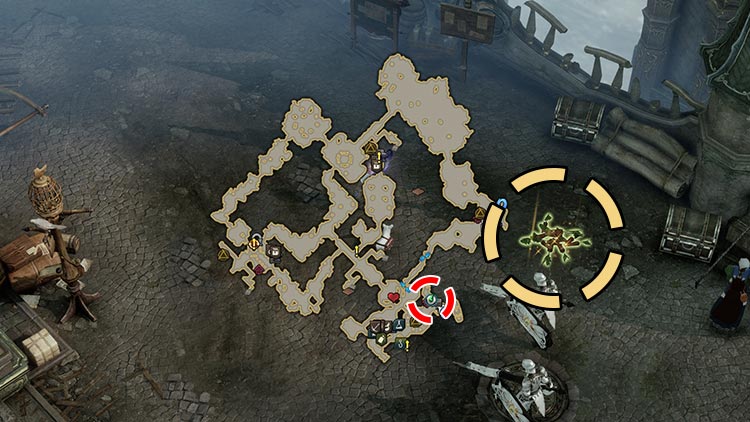
Bellion Ruins

This hidden quest line has two prerequisites. You must first complete the 3rd quest in that quest line for Another Story #2, Moon Looking at the Sky , before you are able to take the quest, Loner , shown below from Dog . Once completing that quest from Dog , you are able to take the hidden quest inside the building. For more information on Another Story #2, please click here .
The hidden quest line will reward you 4x Honor Leapstone (Bound) , 1x Solar Blessing (Bound) , 4x Great Honor Leapstone (Bound) and 2x Solar Protection (Bound) .
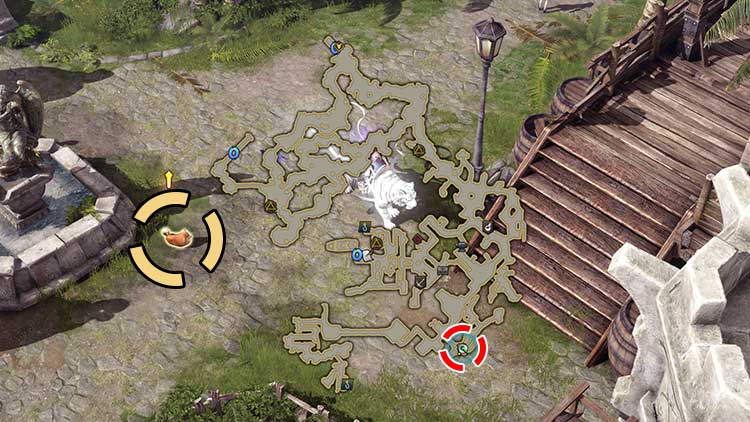
This hidden quest line is actually Another Story #1. The prerequisite quests for it require the main story quest for South Vern to be completed. For more information on the entire hidden quest line, please click here .
The two prereqs are shown below. The prerequisite quest and hidden quest will reward you 3x Legendary - Uncommon Card Pack , 3x Legendary - Rare Card Pack , 1x Solar Grace (Bound) , 10x Honor Leapstone (Bound) and 1x Honor Shard Pouch (M) .
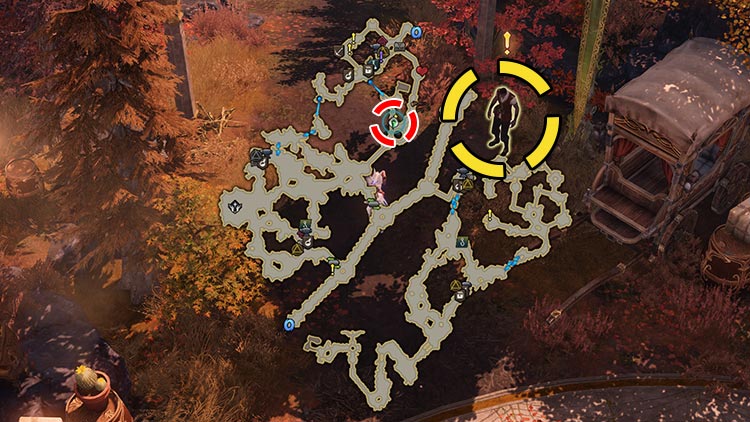
Unlocking South Vern Una's Tasks
South Vern's Una's Tasks reputation rewards are decent. If not decent, better than most other reputation rewards that occur in other regions.
The prerequisite to unlocking this Una's Tasks are the two quests shown below; Haiger's Daughter, Lily and The Meaning of Lilies .
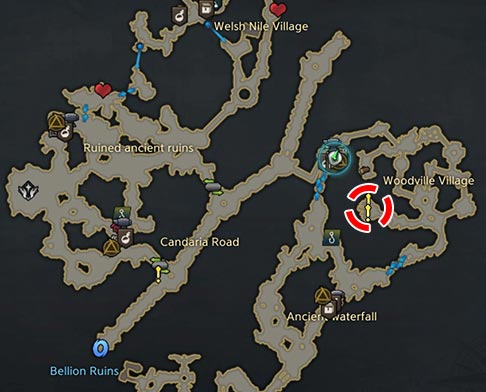
Rewards 3x Legendary - Rare Card Pack after 6 days Rewards 3x Legendary - Epic Card Pack after 15 days
The prerequisite for #2 is the quest Ealyn's Summon shown in the 1st image. It is the 1st quest in the quest line for Another Story #2. The prerequisite for #3 is the 2nd quest in the quest line, Investigate Candaria's Holy Statue shown in image 2. Each quest in the quest line appears after daily reset.
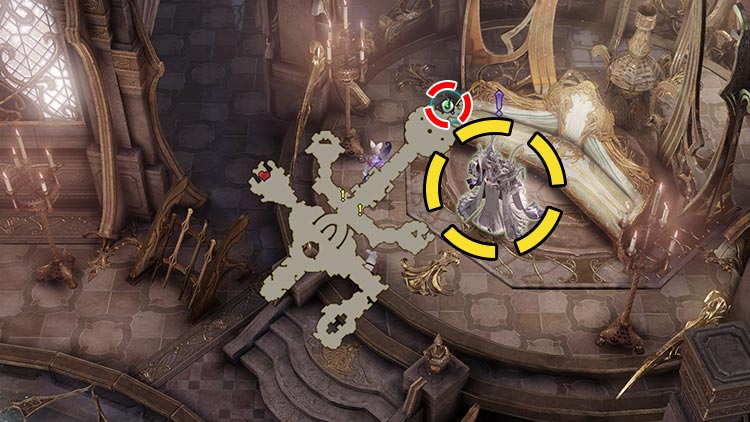
Evan, Wandering Merchant - Spawn Times and Locations
The Wandering Merchant appears only in 2 zones. When he spawns, he will be in all channels and stay for about 6 hours.
Rapport Items Feather Fan Mockup Firefly Febre Potion Necromancer's Records
Cards Satra Card Killian Card Lujean Card Vern Zenlord Card Xereon Card
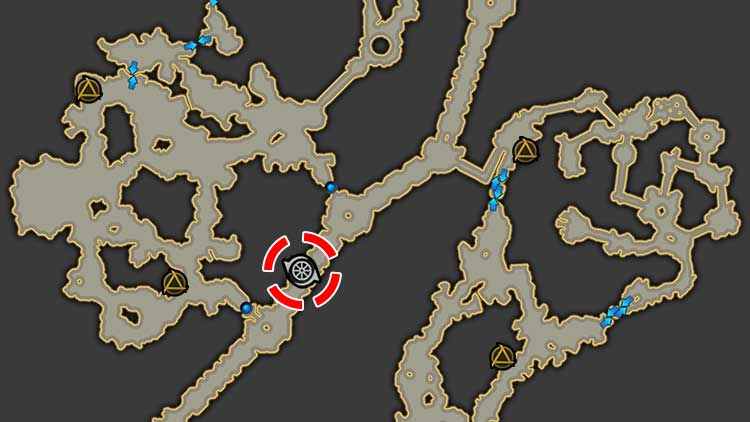
Cooking Guide
The cook is an important NPC that is available in all regions of the game. This NPC helps you craft some cooking entries for your adventure tome. The South Vern cook is located in Candaria Territory .
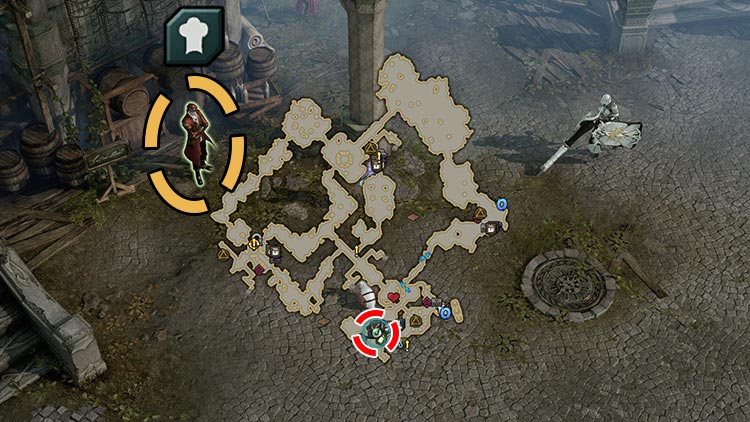
To craft Steamed Oysters with White Wine , you need to pick up 30x Fresh Oyster and craft at the cook. The locations for the ingredient are located at the red dots below. Click the image to get a higher res version. The easiest way I've farmed for the ingredients were to farm them after Chaos Gate spawns because people will be doing their maps and there will be plenty of channels. I just rotate between the 4 in the middle of the map and switch channels afterwards.

To craft this at the cook, you need 6 recipes.
- Kandarian Cold Lager Recipe, Part One and Kandarian Cold Lager Recipe, Part Four can be bought at the Cooking Ingredient Merchant for 200k Silver and 450k Silver respectively.
- Kandarian Cold Lager Recipe, Part Three , kill monsters in the shaded area in the image for a random drop.
- Kandarian Cold Lager Recipe, Part Five , pick up in the circle shown in the image.
- Kandarian Cold Lager Recipe, Part Six , kill monsters in the shaded area in the image for a random drop.

Buy Chicken Wings for 1 million Silver from the Cooking Ingredient Merchant in Bellion Ruins. Use it to craft Bellion Wings at the cook.
Note: Additionally, you need to be inebriated before being able to eat this. Drink 3x Kandarian Cold Lager first. Simply re-fill Empty Kandarian Cold Lager Bottle at the Cook for more stacks. You do not need to get 3 unique drinks.
The two ingredients below are required to craft Vernilaya . You need 10x Ingredient: Meat and 30x Ingredient: Seafood .
To enter the hidden location for Cooking Ingredient 1 , you need 350 Charisma to pass through the waterfall. To enter the hidden location for Cooking Ingredient 2 , you need 350 Kindness.
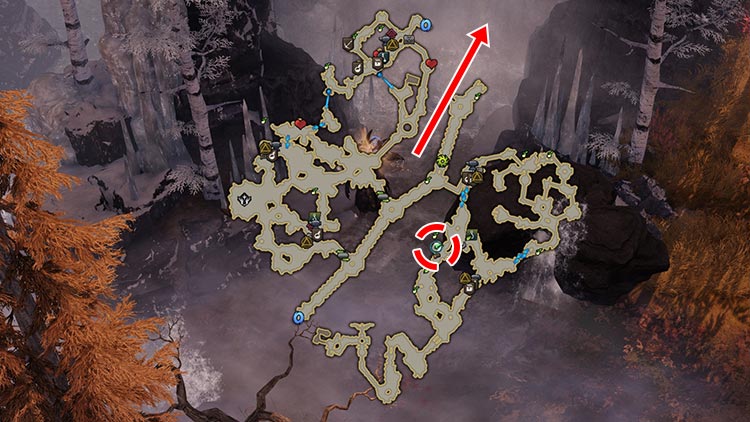
You will need to pick up this Crayfish at this location before being able to craft Crayfish with Vegetable . To be able to pick up the ingredient, you need to have a certain number of buffs.
- First buy 5x Gray Bait Material , 1x Red Bait Material , and 2x Orange Bait Material at the cooking ingredient merchant in Bellion Ruins.
- DO NOT USE THEM YET . First, move to Candaria Territory and then use everything you just bought.
- Pick up Crayfish at any of these two locations below. Use it to craft Crayfish with Vegetable at the cook.
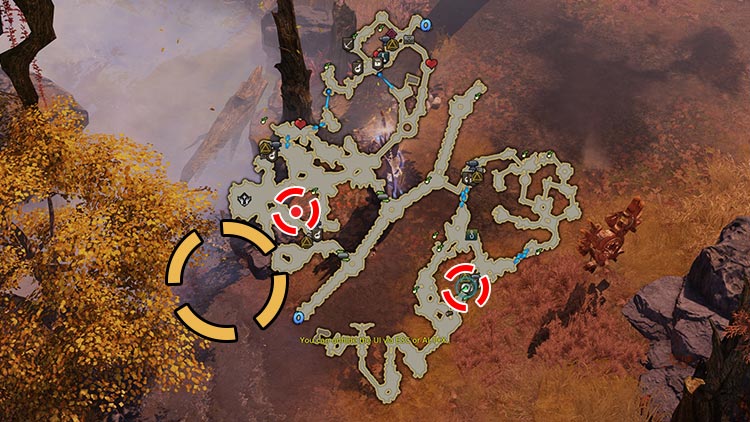
Acquiring Vernese Brisket is just a matter of waiting for cooking ingredients to expire. It will take around 8 hours to acquire this food. Follow these instructions below to correctly craft it.
- Buy Uncommon Brisket and Brisket Dry Rub from the cooking ingredient merchant in Bellion Ruins.
- Craft Brisket Being Cooked at the cook using the above 2 ingredients.
- Wait 2 hours for it to turn into Brisket Ready to Be Applied with Rub . Use it within 10 minutes to turn it into Brisket Being Cooked Again or else it will expire.
- Wait 2 hours for Brisket Being Cooked Again to turn into Brisket, Ready for Dry Rub . Use it within 10 minutes to turn it into Reheated Brisket or else it will expire.
- Wait another 2 hours for Reheated Brisket to turn into Brisket Ready to Be Applied with Rub . Use it within 10 minutes to turn it into Nearly Cooked Brisket or else it will expire.
- We're almost there! Wait 2 more hours for Nearly Cooked Brisket to turn into Vernese Brisket .
Vernese Brandy Magica is acquired by reaching Trusted with NPC Thar .
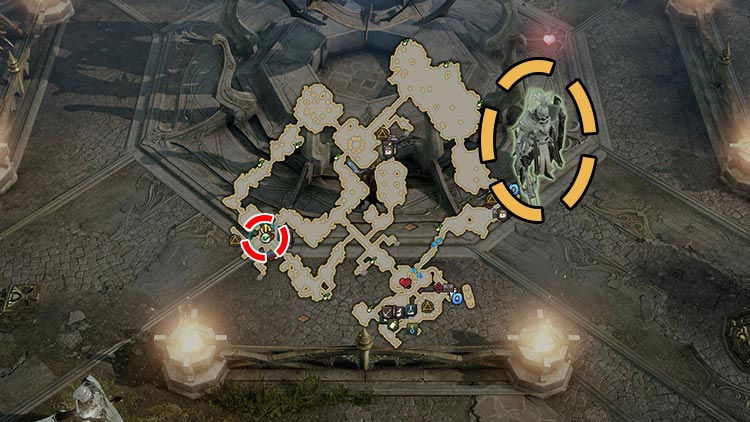
Vista Guide
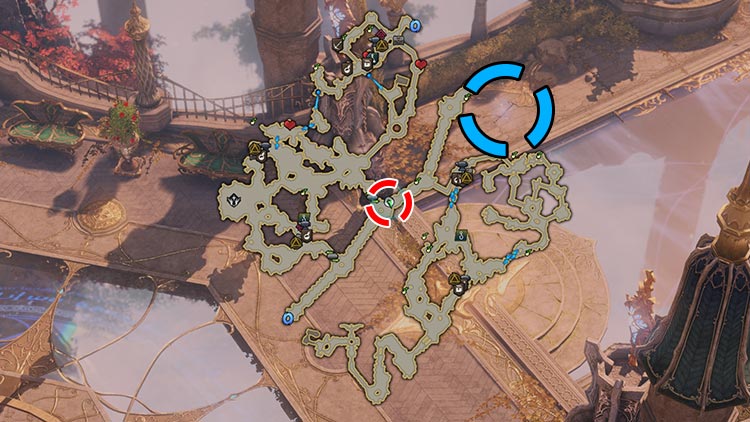
Unique Monsters Guide

Candara Estate

Field Boss Thunderwings
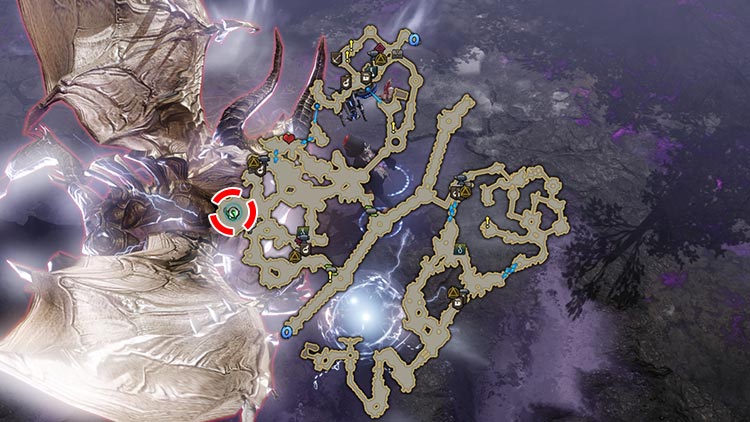
Another Story Guide
1. unstoppable.
The 1st Another Story is the final quest in a quest line which also has 2 prerequisites before you can take it.
- Do prerequisite quest The Kidnapped and Lost Goblin as shown in images 1 and 2.
- Pick up the start of the quest line by interacting with this hidden object in Rania Village in image, Lost Item .
- 2nd quest in the quest line, The Slum's Ranger , is shown in image 4.
- The 3rd and 4th quests in the quest line, Insatiable and Vanished Louvere , are started by hidden objects as shown in image 5 and 6.
- Finish the quest line as shown in image 7 and 8.

2. Termination
The 2nd Another Story is time-gated. It requires a 5-part quest line to be done before the quest shows up. So it will take you 5 days to complete this.
- Pick up this purple quest, Ealyn's Summon from Ealyn in Vern Castle . Complete it.
- Wait for daily reset. The next quest, Investigate Candaria's Holy Statue will be given by Speaker Alberto . He appears at the bottom of the map, shown in the 2nd image in the slider.
- The rest of the quests in the quest line: The Moon Looking at the Sky , Eye of the Typhoon , Sunset , will all show up on subsequent daily resets. So it will take you 3 more days to complete.
- After finishing the quest line, the purple quest Termination will appear from Speaker Alberto .

Hidden Story Guide
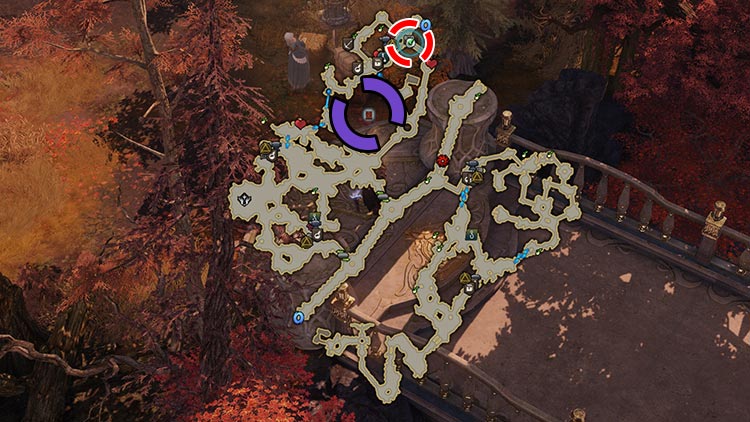
Written by Yaen
- Terms of Service
- Privacy Policy
- Refund Policy
- Cookie Policy
© 2024 Maxroll Media Group, All Rights Reserved
CHAPTER ONE Russia in the Age of Peter the Great By LINDSEY HUGHES Yale University Press Read the Review I
I. RUSSIA IN 1672
Russian Bethlehem, Kolomenskoe, You delivered Peter to the light! You the start and source of all our joy, Where Russia's greatness first burned clear and bright.
Peter Alekseevich Romanov was born in or near Moscow at around one in the morning on Thursday 30 May 1672. A patron saint's `measuring' icon of the apostle Peter made shortly after his birth showed the infant to be nineteen and a quarter inches long. The future emperor's exceptional height was clearly prefigured, but the time and place of his birth, like much else in his life, have been the subject of controversy. For want of concrete evidence locating it elsewhere, the event may be placed in the Kremlin in Moscow, but legends persist, as in the verse by the poet Sumarokov above, that Peter was born in the village of Kolomenskoe to the south of Moscow, where his father had built a wooden palace, or even in Preobrazhenskoe, which later became Peter's favourite retreat and the base for his new guards regiments, formed from the `play' troops of his boyhood. As for the date, most sources accept 30 May, as did Peter himself by honouring St Isaac of Dalmatia, whose feast falls on that day. But at least one record gives 29 May, following the old Russian practice of starting the new day not at midnight but at dawn.4 In those countries which had adopted the Gregorian calendar (which Russia did only in 1918) the date was ten days ahead of those which still followed the older, Julian calendar, and 30 May fell on 9 June. Contemporary Russian chroniclers (using not arabic numerals but Cyrillic letters with numerical equivalents) recorded the year of Peter's birth as not 1672 but 7180, following the Byzantine practice of numbering years from the notional creation of the world in 5509 BC. The year 7181 began on 1 September 1672, which, following the usage of Constantinople, marked the start of the Muscovite new year.
These peculiarities of time and record keeping provide a foretaste of the different customs observed in the Russia where Peter was born and the West into which he was later to forge a `window'. On the eve of the new century, in December 1699, Peter himself decreed that official records would henceforth adopt calendar years from the birth of Christ in the manner of `many European Christian nations'. When he died on 28 January 1725, there were no arguments about how the date should be recorded. It is appropriate that questions of time and chronology should arise at the outset of Peter's life, for he was to be obsessed with time and its passing, believing that `wasted time, like death, cannot be reversed'. Traditionalists denounced the tsar for tampering with `God's time' by changing the calendar. There were even rumours that the Peter who was to adopt the title `emperor' in 1721 was not the Peter who had been born in 1672. We shall return to these matters later, but let us take a closer look at the Russia into which Peter was born.
Peter's parents had been married for less than eighteen months when he arrived. On 22 January 1671 nineteen-year-old Natalia Kirillovna Naryshkina married forty-two-year-old Tsar Alexis (Aleksei) Mikhailovich, whose first wife Maria Miloslavskaia had died in 1669 at the age of forty-three after giving birth to her thirteenth child, a girl who did not survive. Given a more robust set of male half-siblings, Peter might never have come to the throne at all. His father's first marriage produced five sons, but in 1672 only two were still alive. The heir apparent, Fedor, born in 1661, had delicate health, while Ivan, born in 1666, was mentally and physically handicapped. There were six surviving half-sisters: Evdokia, Marfa, Sophia, Ekaterina, Maria, and Feodosia, ranging in age from twenty-two to ten. They were not regarded as direct contenders for power: no woman had ever occupied the Muscovite throne in her own right, and the policy of keeping the royal princesses unmarried minimized the complications of power-seeking in-laws and inconvenient offspring through the female line. The practice of keeping well-born women in virtual seclusion also meant that they were unknown to the public.
When Tsar Alexis died at the age of forty-seven in January 1676, Fedor succeeded him without the formal appointment of a regent, even though he was only fourteen. (Rumours of attempts to place three-year-old Peter on the throne in his stead may be discounted.) Twice in the next six years Peter narrowly escaped being pushed further down the ladder of succession. Fedor's first wife, Agafia Grushetskaia, and her newborn son Il'ia died in July 1681. His second wife, Marfa Matveevna Apraksina, was left a widow after only two months of marriage, by Fedor's death in April 1682. Rumours that she might be pregnant proved unfounded. But this is to leap ahead. In 1672 there was every prospect of Tsar Alexis continuing to rule for many years, and a fair chance, given infant mortality rates, that Peter would not survive for long. Modern readers will treat with scepticism the intriguing story recorded by one of Peter's early biographers to the effect that the royal tutor and court poet Simeon Polotsky predicted Peter's rule and future greatness by the stars on the supposed day of his conception, 11 August 1671.
Many pages of print have been devoted to Peter's childhood and adolescence. His first two decades will be considered here only briefly, in order to give a context for the changes which he later forced upon Russia--the main subject of this book. I will begin by dispelling a few misconceptions, such as that Peter's early environment was closed and stultifying, dominated solely by Orthodox ritual and concepts. In fact, seventeenth-century Romanov childrearing practices did not exclude `modern' elements. For example, Peter's interest in military affairs was stimulated in the nursery, where he, like his elder brothers before him, played with toy soldiers, cannon, bows and arrows, and drums. Military affairs were the right and proper concern of a tsar almost from the cradle. His father had gone to war with his troops, as Peter was well aware and was proud to recall in later life. On the other hand, Peter's prowess as a soldier, virtually from the cradle (a contemporary compared him to the young Hercules, who strangled serpents), has been greatly exaggerated. The myth that Peter was already a cadet at the age of three has been refuted: in fact, at that age, Peter still had a wet-nurse. Toy weapons were supplemented by spades, hammers, and masons' tools, which no doubt fostered Peter's love of mechanical crafts. The fiercest of Peter's boyhood passions--his love of ships and the sea--is at first sight harder to explain. Why should a boy raised in a virtually land-locked country with no tradition of seafaring have developed such a passion? It is even said that as a boy Peter had a dread of water. But Russia's naval inexperience should not be exaggerated. Most major Russian towns were situated on rivers, which small craft plied. Russians may not have been expert sailors on the high seas, but they knew how to navigate inland waters, and Russian peasant navigators had long sailed the northern coastline. Peter did not see the open sea until he was twenty-one, but there was no lack of stimuli to the imagination closer to hand: toy boats, maps and engravings, and, what he himself identified as the spark which lit the flame, the old English sailing dinghy, the `grandfather of the Russian fleet', which he discovered in the outhouse of a country estate. The fact that it should have found its way to Moscow is not so surprising when one considers that English sea-going vessels had been docking on the White Sea since the 1550s, and that Tsar Alexis had commissioned Dutch shipwrights to build a small fleet on the Caspian Sea in the 1660s.
In some respects, however, Peter's introduction to the wider world actually lagged behind that of his half-siblings. His brothers Fedor and Alexis (who died in 1670), and even his half-sister Sophia, were taught by the Polish-educated monk Simeon Polotsky, who gave instruction in Latin, Polish, versification, and other elements of the classical syllabus. Polotsky died in 1680, before he had the chance, had it been offered, to tutor Peter. His protege, Silvester Medvedev, was at daggers drawn with the conservative patriarch, Joachim, who, as adviser to Peter's mother, would scarcely have recommended a suspect `Latinizer' as the tsarevich's tutor. Peter thus received indifferent tuition from Russians seconded from government chancelleries; they included Nikita Zotov and Afanasy Nesterov, an official in the Armoury, whose names first appear in records as teachers round about 1683. Not only did Peter's education lack scholarly content; it also seems to have been deficient in basic discipline. His prose style, spelling, and handwriting bore signs of lax methods for the rest of his life. It should be added that there was no question of Peter receiving his education from a Muscovite university graduate or even from the product of a local grammar school or its equivalent. There were no universities in Muscovite Russia and no public schools, apart from some training establishments for chancellery staff in the Kremlin. In fact, clerks ( d'iaki and pod'iachie ) and clerics were the only two orders of Muscovite society who were normally literate, many parish priests being only barely so.
The inadequacies of Peter's primary education were later offset by practical skills learned from foreigners, whom he was able to encounter in Moscow thanks to the policies of his predecessors. Foreigner-specialists first started arriving in Muscovy in significant numbers during the reign of Ivan IV (1533-84). Their numbers increased when Peter's grandfather, Tsar Michael (1613-45), reorganized certain Russian infantry regiments along foreign lines. In 1652 Tsar Alexis set aside a separate area of Moscow called the `New Foreign' or `German' Quarter to accommodate military, commercial, and diplomatic personnel. It was here that Peter encountered officers such as Patrick Gordon, Franz Lefort, and Franz Timmerman, his teachers and companions in the 1680s and 1690s. Residents of the Foreign Quarter also made their mark on Russian elite culture. From the 1650s several foreign painters were employed in the royal Armoury workshops. Alexis is the first Russian ruler of whom we have a reliable likeness, his daughter Sophia the first Russian woman to be the subject of secular portraiture. It was the Foreign Quarter which in 1672 supplied the director and actors for Russia's first theatrical performance. Unlike portraiture, however, which quickly became more widespread, theatricals were discontinued after Alexis's death. During Sophia's regency (1682-9) Huguenots were offered sanctuary in Russia, Jesuits were admitted to serve Moscow's foreign Catholic parish, and invitations were issued to foreign industrialists and craftsmen. In the 1670s and 1680s foreigners were no longer a rarity on the streets of Moscow, and were also well represented in commercial towns on the route from the White Sea port of Archangel.
Of course, Moscow was not the whole of Russia, any more than a few relatively outward-looking individuals in the Kremlin were representative of Moscow society as a whole. Most Muscovites, from the conservative boyars who rubbed shoulders with them to the peasants who rarely encountered one, regarded foreigners as dangerous heretics, and viewed foreign `novelties' and fashions with intense suspicion and even terror. During the reign of Peter's immediate predecessors, foreigners were still in Russia on sufferance, tolerated as a necessary evil. The building of the new Foreign Quarter in 1652 was actually an attempt to concentrate foreigners and their churches in a restricted locality, away from the city centre, where they had lived previously. Patriarch Joachim urged that mercenaries, the most indispensable of foreign personnel, be expelled, and non-Orthodox churches demolished. Russian culture was prevented from falling further under foreign influence by strict controls. For example, publishing and printing remained firmly in the hands of the Church. It is a striking statistic that in the whole of the seventeenth century fewer than ten secular titles came off Muscovite presses, which were devoted mainly to the production of liturgical and devotional texts. There were no Russian printed news-sheets, journals or almanacs; no plays, poetry or philosophy in print, although this lack was partly compensated by popular literature in manuscript, a flourishing oral tradition, news-sheets from abroad (albeit restricted to the use of personnel in the Foreign Office), and foreign books in the libraries of a few leading nobles and clerics. Presses in Kiev, Chernigov, Vilna, and other centres of Orthodoxy supplemented the meagre output of Moscow printers. Russians were still clearly differentiated from Western Europeans by their dress, although a number were tempted by Polish influence to don Western fashions in private. According to Tsar Alexis's decree of 1675, `Courtiers are forbidden to adopt foreign, German ( inozemskikh i nemetskikh ) and other customs, to cut the hair on their heads and to wear robes, tunics and hats of foreign design, and they are to forbid their servants to do so.'
The `courtiers' to whom this warning was addressed formed the upper echelons of Russia's service class. Sometimes loosely referred to as `boyars', roughly the equivalent of the Western aristocracy, they belonged to noble clans residing in and around Moscow. The upper crust were the `men of the council' ( dumnye liudi ), the so-called boyar duma, which in the seventeenth century varied in number from 28 to 153 members. Those in the top rank were the boyars proper ( boiare ), next the `lords in waiting' ( okol'nichie ), followed by a smaller group dubbed `gentlemen of the council' ( dumnye dvoriane ), and a handful of `clerks of the council' ( dumnye d'iaki ). All enjoyed the privilege of attending and advising the tsar. Membership of the two top groups was largely hereditary. Unless there were contrary indicators (e.g., serious incapacity or disgrace) men from leading families generally became boyars in order of seniority within their clan. Their numbers were swelled by royal in-laws (marrying a daughter to the tsar or one of his sons usually boosted a family's fortunes) and by a handful of men of lower status who were raised by royal favour. The council's participation in decision making is indicated by the formula for ratifying edicts: `the tsar has decreed and the boyars have affirmed' ( tsar' ukazal i boiare prigovorili ). Nobles immediately below the `men of the council' (often younger aspirants to the grade) bore the title `table attendant' ( stol'nik ), a reference to duties which they had once performed and in some cases still did. Below them were `attendants' ( striapchie ), Moscow nobles ( dvoriane moskovskie ), and `junior attendants' ( zhil'tsy ). In peacetime Moscow nobles performed a variety of chancellery and ceremonial duties. In wartime they went on campaign as cavalry officers. On duty, be it military or civil, they bore their court ranks: boiarin, okol'nichii, stol'nik and so on; there was no differentiation by office.
In 1672 commissions, appointments, and other placings, such as seating at important banquets, were still in theory governed by the code of precedence, or `place' system ( mestnichestvo ), which determined an individual's position in the hierarchy of command by calculations based on his own and his clan's service record and his seniority within his clan. It was considered a great dishonour to be placed below someone who, regardless of ability, was deemed to merit a lower `place'. Such an insult gave grounds for an appeal to the tsar. Increasingly, mestnichestvo was suspended in order to allow the Crown a freer hand in appointing officers. For some campaigns it was ordered that military rolls be drawn up `without places' ( bez mest ).
With the exception of members of the elite sent to serve as provincial governors ( voevody ), outside Moscow the ruler relied on a larger group of the `middle servicemen', provincial gentry ( gorodovye dvoriane ), and `junior servicemen' ( deti boairskie , literally and misleadingly `children of boyars') to perform policing duties and swell the ranks of the army in wartime. All the categories described above, it should be repeated, were counted among the elite and enjoyed certain privileges, the first of which was exemption from tax and labour burdens ( tiaglo ). The second was the right to land and serfs. Most of the Moscow elite owned both inherited estates ( votchiny ) and service lands ( pomest'ia ), the latter, in theory, granted and held on condition of service, but increasingly passed from generation to generation. The peasants living on both votchina and pomest'e holdings were serfs, the property of their landlords, who could freely exploit their labour (in the form of agricultural work and other duties) and collect dues (in money and kind). It should be noted, however, that nobles were not automatically supplied with serfs. Some of the top families owned tens of thousands of peasants distributed over dozens of estates, whereas many in the provincial deti boiarskie category owned only one or two peasant households, and in some cases worked their own plots. The Muscovite Crown also deployed non-noble servicemen ( sluzhilye liudi po priboru ). Men in this category were subject to a service, not a tax requirement, but they could not own serfs. They included the strel'tsy (`musketeers'), who formed army units in wartime and did escort and guard duty in peacetime, carrying on small businesses and trades when off duty; artillerymen ( pushkari ), and postal drivers ( iamshchiki ). Civilian personnel in the non-noble service category included secretaries and clerks ( d'iaki, pod'iachie ), the backbone personnel of the government chancelleries.
Most of the non-noble residents of Russia's towns were bound to their communities by tax obligations, apart from a handful of chief merchants ( gosti ), who dealt in foreign trade. Including merchants of the second and third grades ( gostinnye and sukonnye sotni ) and the mass of clerks, artisans, and traders, or `men of the posad ' ( posadskie liudi ), the total registered male urban population in the 1670s has been estimated at 185,000. In addition, substantial numbers of peasants resided temporarily in towns, which also had shifting populations of foreigners and vagrants, but lacked many of the native professional categories--bankers, scholars, scientists, doctors, schoolteachers, lawyers, and actors--to be found in most contemporary Western European towns of any size.
If townspeople were less numerous and played a less prominent role in Muscovy than they did in Western European countries, the opposite was probably true of church personnel. The Russian clerical estate was divided into `white' (secular) and `black' (monastic) clergy, the former group, consisting of parish priests and deacons, who were obliged to marry. The prelates--the patriarch, metropolitans, bishops, and abbots of monasteries--were drawn from the celibate black clergy, who also formed the monastic rank and file. The ecclesiastical estate enjoyed considerable privileges. Apart from the royal family and the nobles, only they could own serfs (although, strictly speaking, peasants were attached to monasteries and churches, not individuals). They were exempt from taxation. They had access to church courts. But the rural clergy, like the lesser rural gentry, were often barely differentiated in wealth and education from the mass of the population.
This brings us to the masses themselves: rural dwellers engaged in working the land-- pashennye liudi . Roughly 50 per cent were serfs or bonded peasants, living on lands owned by the royal family ( dvortsovye ), nobles ( pomeshchichie ), or the Church ( tserkovnye ). The rest were `State' peasants ( gosudarsvennye ), not bound to any one landlord, but obliged to pay taxes to the State and perform labour duties as required--for example, by providing transport and carrying out forestry and road work. All were eligible for military service, which freed them from obligations to their former owners. Another group of `unfree' persons were slaves, who entered into contracts of bondage with richer people (usually, but not invariably, nobles) in return for loans and support. It has been calculated that as much as 10 per cent of the population may have fallen into this category.
Thus, in 1672, it was possible to divide the great majority of people in Muscovy into those who performed service ( sluzhilye liudi ), those who paid taxes ( tiaglye liudi ), and those who served the Church ( tserkovnye liudi ). They included the tsar's non-Russian subjects: various tribespeople who rendered taxes in the form of tribute ( iasak , often in furs) or did occasional military service. Some of the tsar's subjects fell outside these estates: these included socalled wandering people ( guliashchie liudi ) unattached to any locality or category, who were either incapable of performing service or paying taxes--for example, cripples and `fools in Christ'--or who wilfully escaped obligations--runaway serfs, deserters, and religious dissidents, of which the biggest category were the Old Believers, protesters against Nikon's church reform of the 1650s. A number set up communities in remote localities out of reach of the government. Cossack communities, consisting originally of refugees from the long arm of government, maintained a variety of links with Moscow, being either bound in service, like the registered Cossacks of Ukraine, intermittently loyal, like the Cossacks of the Don, or persistently hostile, like the Host of the Zaporozhian Sich.
This, then, was the Russia into which Peter was born, a country, on the one hand, deeply rooted in tradition and in many ways very distinct from Western Europe, where Russia was still regarded as a `rude and barbarous' kingdom, on the other, increasingly open to the influence of Western people and ideas. In the year 1672 the birth of a Russian prince went more or less unnoticed in the rest of Europe, of which Russia was at best a fringe member. There would have been scarcely any speculation about the new prince's eligibility as a marriage partner, since the Muscovite royal family was known to be uninterested in such foreign involvements, although this had not always been the case. The concept of the European community as `a single, integral system of mutually interdependent states', which came into being after the 1648 Treaty of Westphalia, rested on a Protestant-Catholic balance of power in which Orthodox countries barely figured. But Russia was poised to play an increasingly active role in world affairs. In the reign of Alexis, during the socalled First Northern War (1654-60), it entered the wider sphere of international relations when it was pitted against its old enemies Poland and Sweden. War with Poland began in 1654, as a result of Moscow's provocative acceptance of the allegiance of Ukrainian (Little Russian) Cossacks under their leader Bogdan Khmel'nitsky, who were formerly Polish subjects, and ended in 1667 to Russia's advantage, with Left Bank Ukraine (to the east of the River Dnieper) and Kiev brought under the tsar's rule. But there was no progress during the shorter conflict of 1656-61 with Sweden, which had blocked the way to the Baltic since the 1617 Treaty of Stolbovo removed Moscow's narrow foothold on that sea. At the time Sweden's King Gustav Adolph boasted that Russia could not even launch a rowing boat on to the sea without Sweden's permission. When Peter was born, Russia's only seaport was Archangel, on the White Sea. In the south, Russia and Poland vied for possession and domination of the steppes with the Turks and the Crimean Tatars, who barred Russia from the Black Sea. Direct conflict was usually with the Tatars, who exacted a heavy toll of prisoners and livestock, as well as demanding and receiving annual tribute, known as `gifts'. In 1672 the Turks and the Tatars seized parts of Polish (Right Bank) Ukraine, and threatened incursions across the Dnieper into Muscovite territory. It was this crisis which prompted Tsar Alexis to send envoys all over Europe seeking aid for an anti-Turkish league. In 1676 his son Fedor found himself at war with the Turks and the Tatars. After losing the fort at Chigirin on the Dnieper, and fearing a Turkish attack on Kiev, Moscow made an uneasy twenty-year truce with the Tatars at Bakhchisarai, in January 1681.
II. SOPHIA: THE 1680s
On 27 April 1682 Fedor died childless. The same day, Peter, a month short of his tenth birthday, was declared tsar, on the grounds that his elder half-brother Ivan was `weak-minded'. Matters might have rested there. Ivan's afflictions evidently precluded him from taking an active role in civil or military affairs. There was no written law of succession to rule out the accession of a younger brother under these circumstances. Observance of primogeniture was a matter of custom rather than constitution. Peter's accession had the support of the patriarch, who intervened in such matters in the absence of mature royal males. But Peter's maternal relatives, the Naryshkins, and their hangers-on, who could expect to enjoy considerable power in Peter's minority and to retain key government posts when he came of age, had not reckoned on a lethal combination of unrest among Moscow's armed guard, the strel'tsy, and the fury of the affronted Miloslavskys, kinsmen of Tsar Alexis's first wife, led by Ivan's sister Sophia, that `ambitious and power-hungry princess', as a contemporary described her.
The Miloslavskys succeeded in harnessing the strel'tsy, who were ultrasensitive to rumours of abuses in high places as a result of a series of disputes over management, pay, and conditions dating from Fedor's reign. After two weeks of negotiations, during which the new Naryshkin government made concessions, to the extent of handing over unpopular officers to strel'tsy mobs, a rumour that Tsarevich Ivan had been strangled by his `ill-wishers' brought rebel regiments to the Kremlin. There on 15-17 May, the strel'tsy settled personal grudges by butchering commanding officers and unpopular officials, and, at the instigation of the Naryshkins' rivals, singled out members of the Naryshkin clan and their associates as `traitors', and slaughtered them. The victims included Peter's uncle, Ivan Naryshkin (who was accused of trying on the crown), and his mother's guardian, the former foreign minister Artamon Matveev, who was accused of plotting to murder Ivan. In all, about forty persons fell victim to axe and pike. The role in all this of Sophia, Peter's twenty-five-year-old half-sister, has been widely debated. Although there is little hard evidence that she had the `Machiavellian' tendencies attributed to her by some writers, still less that she plotted to kill Peter and his mother (who remained unharmed, despite being the easiest of targets), the events of April-May 1682 undoubtedly allowed her to champion the legitimate claim to the throne of her brother Ivan and to emerge as regent over a joint tsardom, with Ivan as senior tsar and Peter as junior.
No attempt will be made here to chart the further outbreaks of strel'tsy unrest after the dynastic question had apparently been settled, or to examine the role of Prince Ivan Khovansky in the events of May-September 1682, sometimes referred to as the `Khovanshchina', which were complicated by the activities of Old Believers, who enjoyed some support from the strel'tsy. We shall be concerned only with those events and features of Sophia's regency which had relevance for Peter's future policies and reforms. The most immediate consequence of the seven-year regency on Peter's own circumstances was that he was by and large relieved of ceremonial duties, which Sophia was happy to have performed at first by Ivan, who was thus given a prominent, active role in the public eye, and later by herself. It is difficult to overestimate the significance of these seven years for Peter's development. They may be regarded as a sort of `sabbatical' from the routine burdens of rulership, which allowed him to pursue his own interests (military games and sailing) and to build up a circle of friends and assistants at a slight distance from traditional clan networks. Members of the boyar elite predominated in Peter's circle, but foreigners and men of lower rank appeared in greater numbers than in the past. Ivan's role as Orthodox figure-head meant that Peter had less contact with the church hierarchy. It should be emphasized that Peter was neither banished nor persecuted. As for the charge that Sophia `stifled Peter's natural light', rather the opposite was true, although some contemporaries believed that lax supervision and too much contact with foreigners and `low' types ruined the tsar's character. On occasion he was still required to do ceremonial duty--for example, at ambassadorial receptions and important family anniversaries--but by and large his being out of Moscow suited him as much as it did Sophia. If it had one unfortunate effect, it is that it further alienated Peter from Sophia's chief minister and reputed lover, Prince Vasily Vasil'evich Golitsyn (1643-1714), a man with the sort of talent and vision that Peter could have used, had not hostility towards his sister made it impossible later to employ someone so close to her. Under Golitsyn's direction, the Foreign Office pursued policies which provided both foundations and lessons for Peter's future programme. The major achievement was the 1686 treaty of permanent peace with Poland, which ratified the secession of Kiev and its Right Bank hinterland to Moscow (which had been in dispute since the 1667 Treaty of Andrusovo), and Russian rule over Smolensk, Dorogobuzh, Roslavl', and Zaporozh'e. In return, Russia was to pay the Poles 146,000 roubles indemnity `out of friendship', to sever relations with Turkey and Crimea `on account of the many wrongs committed by the Muslims, in the name of Christianity and to save many Christians held in servitude', and to wage war on Crimea. Other clauses included a ban on the persecution of Orthodox Christians in Poland by Catholics and Uniates (thus allowing the tsar a pretext for intervention), permission for Catholics in Russia to hold divine worship (but only in private houses), recognition of royal titles, encouragement of trade, and a pledge to seek the aid of `other Christian monarchs'. Russian suspicion of Catholics was exploited by Prussian envoys in Moscow, who induced Golitsyn and Sophia to offer sanctuary to Protestant exiles from France. In 1689 commercial treaties were signed allowing Prussia trading rights in Archangel, Smolensk, and Pskov, thereby laying the foundations for future Russo-Prussian co-operation during the 1710s.
Thus Russia joined the Holy League against the Turks, formed in 1684 with papal backing, between Austria and Poland, both of which had lands bordering on the Ottoman Empire, and Venice, Russia's rival at sea, following the relief of the Turkish siege of Vienna in 1683. Russian ambassadors were dispatched all over Europe with appeals for assistance and closer alliance--to Holland, England, Sweden, Denmark, Prussia, France, Spain, Florence, Austria, and Venice. In 1687 and 1689 Vasily Golitsyn led huge armies south to Crimea. On both occasions logistical problems forced the Russian armies to withdraw, on the second occasion with huge losses of men and horses, from thirst and epidemics. Golitsyn's return to Moscow in the summer of 1689, where he was feted as a hero on Sophia's instructions, gave his opponents an opportunity to undermine both him and Sophia, whose public appearances Peter (prompted by his maternal relatives) had begun to criticize. Peter was well into his majority (Fedor, it will be recalled, was tsar without a regent at the age of fourteen); he was married (in January 1689), and his wife, Evdokia Lopukhina, was pregnant; he had troops at his disposal, notably his own `play' regiments and foreign officers; and he had the support of the patriarch. In fact, Sophia's rule was doomed from the start, because it could be perpetuated indefinitely only by disposing of Peter. This she seems never seriously to have contemplated, despite ample opportunities. Even the crisis of August 1689, when Peter believed that the strel'tsy were coming to kill him and fled to the Trinity monastery, may have been engineered by Peter's own supporters in order to force a confrontation between Peter and Sophia which they knew she was unlikely to win, given dissatisfaction with the Crimean campaigns, and which Peter, too wrapped up in his own interests, could not be relied upon to precipitate. August-September saw a stand-off between Sophia and her fast-dwindling forces in the Kremlin and Peter's supporters, massed at the Trinity-St Sergius monastery. The brief clash ended in late September, when Vasily Golitsyn was exiled to the north of Russia, and Sophia was locked up in the Novodevichy convent, were she remained until her death in 1704.
For the rest of his life Peter associated Sophia with the dark forces of opposition, even if he blamed most of the active wickedness on her male supporters. The perpetrators of the so-called Tsykler plot to kill Peter in 1696-7 were executed over the exhumed coffin of Ivan Miloslavsky, identified by several contemporaries as the master-mind behind the 1682 rebellion. `The seed of Ivan Miloslavsky is sprouting,' wrote Peter, when called back to Russia to deal with another strel'tsy revolt in 1698. He apparently recognized Sophia's `great intelligence', but thought it was overshadowed by `great malice and cunning'. Engraved portraits depicting her wearing a crown and carrying royal regalia were sought out and destroyed, but many copies survived, along with painted portraits set against the background of the double-headed eagle bearing the seven Virtues on its wings, eloquent testimony both to Sophia's political aspirations and to the new cultural trends which she encouraged. At least one of Peter's successors did not share his view. Catherine the Great wrote of Sophia: `Much has been said about this princess, but I believe that she has not been given the credit she deserves ... she conducted the affairs of the Empire for a number of years with all the sagacity one could hope for. When one considers the business that passed through her hands, one cannot but concede that she was capable of ruling.'
III. THE MAKING OF A SOVEREIGN: THE 1690s
There are good reasons for devoting some space to the period between the overthrow of Sophia and Golitsyn and the declaration of war against Sweden in August 1700. The fact that these years have generally been regarded as merely a `prelude' to reform has condemned the 1690s to neglect in general histories, which tend to confine themselves to such selected highlights as the Grand Embassy and the Azov campaigns. Yet this decade is vital for understanding both the man and his Russia, the moulding of Peter's priorities and the clarification of the options open to him, both at home and abroad. For a start, a closer examination of the early 1690s reveals the error of assuming an unbroken line of developing `Westernization' from the 1680s into the new century. The 1690s were not merely a bridge between the cautious modernization of the Sophia-Golitsyn regime and Peter's full-blooded post-1700 variant. Some new trends--in art and architecture, for example--continued and flourished, while others were suspended. The 1690s saw a continuing struggle, to use a cliche, between the `old' and the `new', personified in the figures of the two ruling monarchs: `pious' Ivan making stately progress in his heavy brocade robes and `impious' Peter clad in German dress dashing from shipyard to military parade.
In a letter to Tsar Ivan, written between 8 and 12 September 1689, Peter wrote: `And now, brother sovereign, the time has come for us to rule the realm entrusted to us by God, since we are of age and we must not allow that third shameful personage, our sister the Tsarevna S.A., to share the titles and government with us two male persons.' In fact, Peter showed little inclination to `rule the realm'. His preoccupation with his own interests for the first few years, then his prolonged absences, first at Azov, then in the West, ceded the centre to others, to the extent that some of the first actions of the new regime appeared to turn back the clock, taking advantage of the removal of Vasily Golitsyn, the `friend of foreigners', to annul concessions made during Sophia's regency and to adopt closer supervision of foreigners in general, in order to stem the spread of heresy from across the borders. Patriarch Joachim was the prime mover. On 2 October 1689 the Jesuit fathers Georgius David and Tobias Tichavsky were expelled. Sanctions were imposed against Jesuits in particular, not Catholics in general, probably because there were some influential foreign Catholics close to Peter, and Russia was still allied to Catholic powers. A decree of 1690 allowed two priests to serve the foreign Catholic community, but the authorities were to take precautions to ensure that they did not try to convert Russians, visit them in their homes, carry on foreign correspondence or turn out to be Jesuits in disguise. In October 1689 the Protestant mystic Quirinus Kuhlman was burned on Red Square together with his works. P.I. Prozorovsky, governor of Novgorod, was warned to take care that `such criminals should not enter the country and that foreigners who in future arrive from abroad from various countries at the border and in Novgorod the Great and claim that they have come to enter service or to visit relatives or for some other business in Moscow, should be questioned at the border and in Novgorod and detained and not allowed to proceed to Moscow until you receive our royal instructions'. All foreign travellers were to be interrogated and asked to provide certificates and passes, and transcripts of such interrogations were to be made. Just before his death in 1690, Patriarch Joachim called a church council to consider the recantation of the monk Silvester Medvedev, who was accused, among other things, of propagating a Catholic view of transubstantiation. Copies of Medvedev's book Manna were seized and burnt, and its author was defrocked and beheaded in 1691. Another whiff of Old Russia comes from a report of the uncovering in 1689 of a sorcerers' conspiracy, master-minded by Andrei Bezobrazov, who allegedly attempted to undermine the health of Peter and his mother by casting spells `on bones, on money and on water'. The ring-leaders were beheaded or burnt, other `conspirators' flogged and banished. For a few months after Sophia's overthrow the atmosphere was so oppressive that Peter's friend, the Scottish mercenary General Patrick Gordon, contemplated leaving Russia.
But in the midst of this resurgence of the old, the new was asserting itself with unprecedented vigour. Despite the Church's dire warnings about the dangers of contamination by heretics, Peter himself was spending more and more time in the company of foreigners. The Foreign Quarter was only a few miles from the Preobrazhenskoe palace, where Peter spent much of Sophia's regency. Peter became a frequent visitor at the homes of Lefort and Gordon, and soon got to know other foreign soldiers and merchants, attending banquets, weddings, and funerals. Lefort's palace, with a splendidly appointed ballroom added, was turned into a semi-official residence for the sort of reception which it was still difficult to hold in the Kremlin, accompanied by `debauchery and drunkenness so great that it is impossible to describe it'. At about this time Peter probably learned Dutch (from Andrei Vinius, a government official of Dutch descent), and also took lessons in dancing, fencing, and riding. In February 1690 the birth of Peter's first child, Alexis, was celebrated not only with the customary church services and bells but also with cannon-fire and drum-beats. Foreign-led infantry regiments were drawn up in the Kremlin, presented with gifts and vodka to mark the occasion, and ordered to fire off rounds of shot, `disturbing the peace of the saints and ancient tsars of Moscow'. Over the next few days there were firework displays, more gun salutes, banquets, and feasts. Conservatives took retaliatory action. On the patriarch's orders, a banquet on 28 February was held without the now customary foreign guests, who were banned; but the next day the tsar dined with Patrick Gordon. Then in March Joachim died. His `Testament', which denounced the policy of hiring foreigners and deplored toleration of other faiths, has been described as the `last gasp' of Old Russia:
May our sovereigns never allow any Orthodox Christians in their realm to entertain any close friendly relations with heretics and dissenters--with the Latins, Lutherans, Calvinists and godless Tatars (whom our Lord abominates and the church of God damns for their God-abhorred guile); but let them be avoided as enemies of God and defamers of the Church.
Joachim's successor was Adrian, consecrated on 24 August 1690. He was to be Russia's last patriarch, his office left vacant after his death in 1700, and abolished altogether in 1721.
As long as Tsar Ivan was alive, the old guard still retained a figure-head in the Kremlin. After the overthrow of Sophia and Golitsyn, the old Muscovite court life, with its liturgical emphasis, was resumed with a vengeance, cleansed of the `unseemly' female variants introduced by Sophia. Festivals gave special prominence to the history of the Russian Orthodox Church, celebrating earlier hierarchs who had assumed a strong political role, such as Metropolitans Philip and Alexis, and paying homage to the ruling dynasty with requiems for departed royalty (such as Tsarevich Alexis Alekseevich, whose death had not been marked in previous years). Old palace protocols persisted, on paper at least; for example, the practice of listing in order of rank all the nobles `in attendance' ( za nimi Velikimi Gosudariami ) on the tsars at such occasions as summer outings ( pokhody ) to country residences and monasteries. The Church continued to make its contribution to the business of warfare and government: in April 1695 General Avtamon Golovin was issued with icons of the Saviour, the Mother of God, and St Sergius and ten pounds of incense to carry in the campaign to Azov. In September 1697 Prince M. Ia. Cherkassky, the new governor of Tobol'sk, received a set of instructions, the first of which was to go to the Cathedral of the Holy Wisdom and hear prayers for the tsar and his family read by Metropolitan Ignaty of Siberia. A few months later Patriarch Adrian issued a long instruction to churches and monasteries on priorities and procedures.
Despite the apparent vigour of tradition, the keepers of the palace records could not conceal the fact that one of the tsars was opting out of the usual rituals. Nowhere is the spirit of the new better illustrated than in an entry recorded shortly after Joachim's death. On 27 April 1690 (April was traditionally the start of the royal pilgrimage season) `the Great Sovereign Peter Alekseevich deigned to visit Kolomenskoe'. For his trip a rowing boat was got up to look like a sailing ship; the boyars followed in two boats and strel'tsy went in front in seven, and `as they sailed along the water there was firing from cannon and hand guns'. The `play' regiments, Peter's private troops, went along in smaller craft. Tsar Ivan travelled by land. Thus we see two tsars, one firmly rooted in old Russia, the other looking to new horizons. (Thirty-four years later, in 1724, Peter again travelled to Kolomenskoe along the river, in a small flotilla with Russian and foreign guests who had gathered in Moscow for the coronation of his second wife, Catherine. The interior of the old wooden palace, it seems, had been preserved exactly as it was in the tsar's youth.) In May 1690 we find Peter making a tour of monasteries, but more often than not Ivan carried out such duties alone. This turn of events was noted by contemporaries. Boris Kurakin records: `First the ceremonial processions to the cathedral were abandoned and Tsar Ivan Alekseevich started to go alone; also the royal robes were abandoned and Peter wore simple dress. Public audiences were mostly abandoned (such as were given to visiting prelates and envoys from the hetman, for which there were public processions,); now there were simple receptions.'
Many of Peter's unofficial activities are recorded in the diary of Patrick Gordon, which provides a secular alternative to the old records which were so deeply rooted in the religious calendar. We learn that on 30 May 1690 Peter spent his birthday at Preobrazhenskoe enjoying gun salutes and target practice. On 19 January 1691 Peter visited P. V. Sheremetev, and the next day Gordon had such a dreadful hangover that he could not get out of bed until the evening. A dinner at Boris Golitysn's on 16 May had similar consequences. And so on. Royal account books for 1690-1 show numerous entries for orders for `German dress' in the royal workshops, made from materials bought from foreign merchants and intended for Peter and members of his play regiments. Peter's enthusiasm for things foreign is indicated by the motley collection of foreign goods shipped to Archangel in 1692: mathematical instruments, two globes, a large organ, four large clocks, five barrels of Rhine wine, and a barrel of olive oil.
The new was taking its place alongside the old. After the traditional blessing of the waters at Preobrazhenskoe on 1 August, for example, there was firing from guns. Tsaritsa Natalia's name-day celebrations on 27 August 1691 combined the usual church services, visits from churchmen and receipt and dispensing of gifts on the tsaritsa's behalf, with a reception of visitors by the tsaritsa herself (from which, however, foreigners were excluded), followed by gun salutes and fireworks. We must also look to the beginning of the 1690s for the origins of one of Peter's most controversial `institutions', the All-Drunken, All-Jesting Assembly or `Synod'. Sometimes dismissed as an adolescent aberration, in fact the Drunken Assembly flourished throughout Peter's reign. The new trends seemed to be growing inexorably, yet how easily it might all have changed. In November 1692 Peter fell ill, and for ten days was at death's door. There were rumours that many of his supporters were preparing to flee. His recovery signalled the resumption of the new life with a vengeance. In July 1693 Peter set off for Archangel to see the sea. This was an `outing' ( pokhod ) for which the record-keepers lacked the vocabulary. The clerks compromised by listing the courtiers in attendance on Peter in the usual manner, but without reference to their destination. Yet this historic journey had much in common with the royal outings of old. The accompanying retinue was listed according to rank, from boyars to secretaries. Peter travelled with a priest, eight choristers, two dwarfs and forty strel'tsy. During Peter's travels Tsar Ivan's activities were solemnly chronicled, and Peter's absences were sometimes noted--for example, at the requiem mass for the late Tsarevna Anna Mikhailovna on 24 July. Moscow was depleted of courtiers. More than ever, the life-style of the two courts diverged. For example, the Russian New Year on 1 September 1693 was celebrated in Archangel with gun salutes from both foreign and Russian ships in the harbour, while back in Moscow, Tsar Ivan, clad in robes of red velvet, `deigned to go from his royal chambers to the cathedral' to hear the patriarch celebrate the liturgy `according to the usual rites'. On occasion, Peter assumed a traditional role, visiting his father's favourite place of pilgrimage, the St Sabbas monastery at Zvenigorod, in May 1693; but after Tsar Ivan's death in January 1696, more and more rituals were enacted without any tsar at all. An old formula was adopted to cover for Peter's absence, be it on campaign or abroad, i.e., the appointment of a small group of deputies to attend services and ceremonials in his stead. An order to this effect was issued: from 2 April to 1 September 1697 `the tsarevichy, boyars, okol'nichie and gentlemen of the duma shall follow behind the holy icons in parades and services', although entries in the palace records reveal that the escort usually comprised only token representatives of these ranks. So, for example, the 1697 Epiphany ceremony was attended by Tsarevich Vasily of Siberia, boyar Prince P. I. Khovansky, okol'nichii S. F. Tolochanov, and Secretary Avatamon Ivanov.
If the early 1690s were a time of exploration and game playing, they also saw the beginnings of serious activity. Peter's first chance to try out his strength came in 1694 when his mother died. The demise of Natalia Naryshkina, a useful figure-head for the leading men, whose power rested upon their relationship to the royal mother, threatened a new configuration of forces which could have worked to Peter's disadvantage. But any thoughts of, for example, using the strel'tsy again against Peter were discouraged by Peter's own forces, based upon the `play' ( poteshnye ) troops. The two regiments took their names from the adjacent royal villages at Preobrazhenskoe and Semenovskoe to the north of Moscow. Their organization--foreign ranks, training, uniforms--was modelled on the new-formation infantry regiments introduced in the 1630s. The story goes that in the 1680s Peter discovered about 300 men idle at a former royal hunting-lodge, and signed them up to play military games. Others were requisitioned from regular units: for example, a drummer and fifteen troopers from the Butyrsky infantry regiment in 1687. Young nobles who might once have served as gentlemen of the bedchamber and in other junior court posts were recruited alongside local lads from a variety of backgrounds. The Semenovsky regiment was formed from the overflow from the Preobrazhensky regiment. Officers and men were all said to be known to the tsar personally. By 1685 the embryonic guards had a scaled-down wooden fortress which Peter named Presburg, with barracks and stables adjacent to the Preobrazhenskoe palace. In deference to foreign expertise, Russians, including the tsar himself, served in the ranks or as non-commissioned officers. A list of officers ( nachal'nye liudi ) of both regiments for 1695 shows that they were all foreigners, although Russian names appear in the next year or so, mostly in the lower officer ranks.
In September 1694 Peter staged the so-called Kozhukhovo manoeuvres, mock exercises which were `partly political in nature', in which some 30,000 men participated. The `campaign' presented Muscovites with a show of strength, as armies commanded by Fedor Romodanovsky, the `king of Presburg', and Ivan Buturlin, the `king of Poland', paraded through the city. The mock battle included an assault with explosives on a specially constructed fortress, which left twenty-four dead and fifteen wounded. Members of both the Lopukhin and the Naryshkin families were placed on the losing side, perhaps to make the point that Peter did not intend to be beholden to any of his relatives unless they proved their worth.
Soon there were to be opportunities for real service. In the wake of the disastrous Crimean campaigns of 1687 and 1689, which attracted little allied support, Russia began to lose confidence in the Holy League, fearing exclusion from any future peace negotiations with the Turks. Even so, Peter was determined to continue the war in the hope of real gain and in 1695 he reopened hostilities in a campaign against the Turkish coastal fort of Azov at the mouth of the River Don, in an attempt to recover Russian prestige, gain a stronger bargaining position with his allies and ward off Turkish attacks on Ukraine. It was widely believed in 1694-5 that Peter was planning to make another assault on the Crimea, `march with a mighty army against the Crim Tartar, having an Artillery of 80 great guns and 150 Mortars', to bring relief to hard-pressed Poland, rumours which Peter was happy to encourage. In the event, he marched not to Perekop, but to Azov, a plan which may have been suggested by Patrick Gordon. Two armies were dispatched: the joint force of B. P. Sheremetev and the Ukrainian hetman Ivan Mazepa to the Dnieper, to deflect the Tatars from the mouth of the Don, and a smaller unit consisting of the Preobrazhensky and Semenovsky guards and strel'tsy on river craft down the Don.
Peter wrote to Fedor Apraksin: `In the autumn we were engaged in martial games at Kozhukhovo. They weren't intended to be anything more than games. But that play was the herald of real activity.' In this, as in some subsequent campaigns, Peter ceded nominal command to others. The commander-in-chief was A. S. Shein, while the tsar marched as a bombardier in the Preobrazhensky regiment. The first Azov campaign was a failure, and the fortress remained in Turkish hands. Peter blamed this on multiple command, tactical errors, and technical deficiencies. Foreign engineering specialists were hired for the next campaign, in an effort to avoid such fiascos as mines planted on ramparts far away from the enemy blowing up 130 Russians without doing any damage to the Turks. The Turks, meanwhile, were able to replenish supplies from the sea, with no Russian ships to hinder them.
This set-back has often been identified as the real beginning of Peter's career, when he was forced to `grow up' and discover `astonishing reserves of energy'. Such formulae should not simply be dismissed as part of a Petrine myth propagated by both tsarist and Soviet writers. Failure did indeed stimulate the implementation of a number of measures, characterized by what was to become the typically `Petrine' use of speed, mass recruitment, and command from above. The prime example was the preparation of galleys at Voronezh on the Don for a renewed campaign in 1696, a huge effort in which thousands of the tsar's subjects were expected to do their bit, from the leading churchmen and merchants, who reluctantly supplied the cash, to the hapless labourers drafted in to hack wood in terrible conditions. Both river craft and seagoing vessels were to support an army of some 46,000 Russian troops, 15,000 Ukrainian Cossacks, 5,000 Don Cossacks, and 3,000 Kalmyks. At the end of May 1696, Peter's land and sea forces laid siege to Azov. By 7 June a Russian flotilla was able to take to the sea and cut off access to Turkish reinforcements.82 Apart from the use of sea power, Russian success was aided by General Gordon's plan of a rolling rampart ('the throwing up a wall of earth and driveing it on the Towne wall') and the services of Austrian engineers. On 18 July the fortress surrendered.
This victory prompted some striking manifestations of the new culture. In the past, military triumphs had been largely religious affairs, celebrated by parades of crosses and icons headed by chanting priests. Such displays of thanksgiving continued right to the end of Peter's reign--in Russia, as in every other European country, military victory and defeat were interpreted as inextricably linked with God's will--but from now on the religious processions were supplemented, and usually eclipsed, by secular parades bristling with `pagan' symbols. After Azov, triumphal gates of Classical design bearing the legend in Russian `I came. I saw. I conquered' gave a preview of the imperial Roman references and imagery which culminated in the festivities of 1721, when Russia became an empire. There were references to Christian Rome, too, and comparisons of Peter to the Emperor Constantine. In addition to the customary prayers, verses were chanted through a megaphone by State Secretary Andrei Vinius. Peter, wearing German uniform, marched in the parade behind the official heroes Admiral Lefort and General Shein, while the religious authority was parodied by `prince-pope' Nikita Zotov in a carriage. It is said that Peter had in mind not only Roman precedents but also the example of Ivan IV, who organized a similar parade after the conquest of Kazan in 1552. This was the first public display of the new manners, which until then had by and large been confined to semi-private indulgence at Preobrazhenskoe or in the Foreign Quarter. This new openness fanned growing popular disapproval of Peter's foreign ways, which expressed itself in full force in 1698, when the strel'tsy revolted.
The 1690s saw interesting developments in art and culture. The semi-Westernized Moscow baroque style of the 1680s matured and spread beyond the capital, where masonry churches and civic buildings displayed decorative features such as Classical columns and carved stone and brick ornament inspired by Western Renaissance and baroque originals. Peter's maternal relatives commissioned so many churches in this style that it is often referred to as `Naryshkin baroque'. One of the finest examples, the Church of the Intercession at Fili, built for Lev Naryshkin in 1690-3, had icons which reflected family history--images of SS Peter and Paul, John the Baptist, Alexis Man of God, and St Stephen, the latter bearing a striking resemblance to the young Peter, who often visited the church. An even more remarkable church, commissioned by Prince Boris Golitsyn on his estate at Dubrovitsy in 1690, dispensed with the traditional cupolas (the tower is capped by an open-work crown) and had statues of saints over the parapets and Latin inscriptions inside.
The painting of the 1690s also exhibits interesting `transitional' features. In January 1692 the Armoury received an order for eleven large pictures for Peter's residence at Pereiaslavl'-Zalessky (where he was experimenting with sailing), the subjects of which were the Saviour, the Mother of God, the martyr Natalia, Alexis Man of God, Alexander Nevsky, Peter and the martyr Evdokia. The family references (Alexander Nevsky, for example, was the patron saint of Peter's second son Alexander, born in October 1691) were almost certainly chosen by Peter's mother rather than Peter himself. But the commission reflected `modern' trends in so far as these were not traditional icon panels but paintings on canvas in frames. There are even more revealing indications of Peter's emerging individual taste: for example, his order in July 1691 for twelve German portraits ( person nemetskikh ) in gilt frames, to be taken to his apartments from the confiscated property of Prince Vasily Golitsyn. In August 1694 a team of painters in the Armoury received orders for twenty-three battle paintings for Peter's apartments, `after the German model', with frames also of German design. Four painters were to take four subjects each, and the rest were to be done by apprentices, `painting different subjects, making use of German pictures [as models]'. In June 1697, when Peter was abroad, the same team of Armoury painters was instructed to paint eight pictures on canvas depicting `troops going by sea, making use of foreign German pictures or engravings, employing the best workmanship'. Again, these were large canvases, evidently executed in some haste, given that the same painters were all dispatched to work in Voronezh in July, and the frames were ordered in August. Painters were called upon to do other jobs to meet new demands: for example, to decorate the new ships built at Voronezh in 1696-7. These few examples indicate clearly the emergence of a distinct secular culture from within the walls of the Moscow Armoury, that early `academy of arts' which housed a secular painting studio separate from the icon-painting workshops only since the 1680s.
It is very difficult to assess the art of the 1690s because, like the 1696 triumphal gates, so few examples have survived. Accurate likenesses of Peter pre-dating the Grand Embassy are notable by their absence. Earlier engravings, such as Larmessen's double portrait of Peter and Ivan (ca. 1687), are mostly imaginative reconstructions. Evidently others existed but have disappeared; thus, in July 1695 an order was given for a printed `persona' of Peter to be stuck on to canvas and framed. Perhaps Peter's restless activity in the 1690s precluded sitting for portraits. Yet it is with portraits that we shall conclude our examination of the 1690s. The first is the most famous (once thought to be the only) image of the young tsar, painted by Sir Godfrey Kneller in London in 1698, now hanging in Kensington Palace in London. The startling contrast between this wholly Western depiction of a monarch and the few surviving images of Peter's father has often been pointed out, but is worth drawing attention to here: the bearded Orthodox tsar of the 1660s with traditional robes and pectoral and crown crosses gives way to the warrior in armour with a warship in the background. For Kneller, Peter was just another European monarch. All traces of Russian `exoticism' were expunged. Indeed, Kneller used the same set formula--column and crown to the left, warship in the background to the right, royal ermine, and armour--as in his 1680s portrait of James II. Yet there are other portraits of Peter from this period which remind us that the break with Old Russia was far from complete. One by the Dutch artist Pieter Van der Werff shows Peter dressed in the Polish style, while in an anonymous portrait now in the Rijksmuseum he wears Russian dress. A similar contrast may be observed in two much smaller images, produced a year later in an entirely different medium. In 1699 two experimental half-roubles were minted. The first, by Vasily Andreev of the Armoury, shows Peter full face, in icon style, wearing the Crown of Monomach. The second is wholly Western, showing the tsar as a Roman emperor in profile, with laurel wreath and mantle. On the reverse is a collar of St Andrew and a coat of arms. On the eve of the new century and the outbreak of the Northern War, the designers had, albeit unconsciously, expressed the contrast between old and new. Which of the two would prevail? In Peter's mind, at least, the contest was already decided, as were the means for augmenting national prestige and prosperity. The focus would shift from the Black Sea to the Baltic and the country which barred Russia's way, Sweden.
(C) 1998 Lindsey Hughes All rights reserved. ISBN: 0-300-07539-1

IMAGES
VIDEO
COMMENTS
Learn how to find and buy exclusive items from regional and merchant ships in Lost Ark. See the schedules, locations, wares and rapport items of each wandering merchant.
Added new merchant location images (thanks Gutterstyle)! Added ZH localization (thanks wuge). More translations welcome (: Added hide by group (thanks Dom). Added back events that were finished (thanks Roland). 3/24/2022: Feature Release: Wandering Merchants! Added actual alarm reminders, alerts and sounds.
Lost Ark, also known as LOA, is a 2019 MMO action role-playing game co-developed by Tripod Studio and Smilegate. It was released in South Korea in December 2019 by Smilegate and in Europe, North America, and South America in February 2022 by Amazon Games. Wandering Merchant Tracker.
The Wandering Merchant is an exclusive NPC that appears in a wooden cart pulled by his surprisingly fashionable Capybara. The Wandering Merchant makes his appearance at Port Jackson, and Smuggler's Bay from Friday-Sunday following the PST timezone. He is the NPC the player visits in order to buy special items not sold anywhere else, with an exclusive currency known as Shards.
Learn how to find and interact with the Wandering Merchants in Lost Ark, who sell unique items and cards for deck building and rapport systems. See the schedule, locations and items of each merchant in different regions.
Among the Wandering Merchants, Nox is the one that shifts their location the most. You may find them in Scraplands, Nebelhorn, Windbringer Hills, Totrich, Riza Falls, and Arid Path at 12:30, 2:30, 5:30, 6:30, 8:30, 9:30. Once you locate Nox, they might be selling the Bergstrom, Stern Neria, or Krause cards and the Energy X7 Capsule and Fine ...
Their spawn times are: 12:30, 2:30, 5:30, 6:30, 8:30, 9:30 (both AM and PM as per the server time) That covers all Wandering Merchant locations in Lost Ark and their spawn times. If you are interested in other locations, NPCs, and more for this game then check out our other Lost Ark guides. Lost Ark PC Tips and Tricks.
Introduction. This article details the most important aspects of the Yorn region. The information here covers details about the Adventure Tome, Wandering Merchant appearance times, Hidden Quests and Mokoko Seeds. Maps of each zone in Yorn and more detailed methods to acquire everything are provided below.
Merchant Burt locations in East Luterra. Merchant Burt is the first Wandering Merchant in the East Luterra region of Lost Ark. His schedule is to show up at 12:30, 2:30, 5:30, 6:30, 8:30, and 9:30 (both AM and PM) server time. He can be randomly found in: Blackrose Chapel. Leyar Terrace. Borea's Domain.
Introduction. This article details the most important aspects of the Feiton region. The information here covers details about the Adventure Tome, Wandering Merchant appearance times, Hidden Quests and Mokoko Seeds.Maps of each zone in Feiton and more detailed methods to acquire everything are provided below.
Learn how to find and buy rare and valuable items from Wandering Merchants in Lost Ark, a popular MMORPG. Discover the schedules, locations, and wares of Regional and Traveling Merchant Ships in different regions.
Hey guys here is my wandering merchants guide, with many ways to actually find them and keep track of what they have my most favorite website, will have it a...
Learn how to find and interact with Wandering Merchants in Lost Ark, special vendors that sell randomized items at specific times and locations. See the list of Regional and Ships Wandering Merchants, their possible items, and their schedules.
In this Lost Ark WANDERING MERCHANT Guide I tell you everything you need to know about the hidden mechanics behind these npc's; where to find them, why they ...
Learn how to find and shop from the rarest and elusive vendors in Lost Ark, the MMORPG. Wandering Merchants appear randomly on different continents and sell exclusive cards, cooking ingredients, and Rapport Items for your Adventurer's Tome.
Wandering Merchants appear 30 minutes after the full hour, for 25 minutes. Only one per continent (that is, a total of 14 different merchants available), with each one operating into one of three schedules. Please note - the times given are for the CET time zone.
Wandering Merchant is a Merchant in Lies of P. From the name itself, this merchant appears in random places to provide you with items that you can purchase. Interacting with merchants helps the player gain Items by trading or requesting certain services for character or equipment progression. The merchants in Lies of P are found stationed in ...
Morris the Wandering Merchant - Spawn Times and Locations. Morris, the Wandering Merchant, randomly appears in 1 of 3 zones: Dyorika Plains, Sunbright Hill, and Flowering Orchard.When Morris spawns, he will be in all channels of one random zone and stay for around 25 minutes. The spawn times for Morris are 1:30, 4:30, 5:30, 7:30, 8:30, and 11:30 for both AM and PM.
Location and Contact. Location Varies. Moscow, ID 83843. (208) 907-1013. Website. Neighborhood: Moscow. Bookmark Update Menus Edit Info Read Reviews Write Review.
Burritos. Big Burrito $9.91. chicken or pork, stewed black beans, cheddar jack, chipotle slaw, charred onion salsa, flour tortilla. Veggie Burrito $8.02. same as "big burrito" but no meat, plus extra cheese and veggies (vegan $6.84) Dessert Burrito $3.77. flour tortilla filled with nutella, sweetened cream cheese, berry jam, then grilled.
Visitors' opinions on Grub Wandering Kitchen. Long live the Grub Truck in Moscow! My absolute favorite Mac n cheese is featured for the month (red wine and steak) and a raspberry brownie! I was the first in line with a following that the Pied Piper would envy Open 10:00-2:30 am. BEST MAC N CHEESE!!
Introduction. This article details the most important aspects of the South Vern region. The information here covers details about the Adventure Tome, Wandering Merchant appearance times, Hidden Quests and Mokoko Seeds. Maps of each zone in South Vern and more detailed methods to acquire everything are provided below.
Including merchants of the second and third grades (gostinnye and sukonnye sotni) and the mass of clerks, ... Some of the tsar's subjects fell outside these estates: these included socalled wandering people (guliashchie liudi) unattached to any locality or category, who were either incapable of performing service or paying taxes--for example ...